IC Australia | Immigration Consultants of Australia
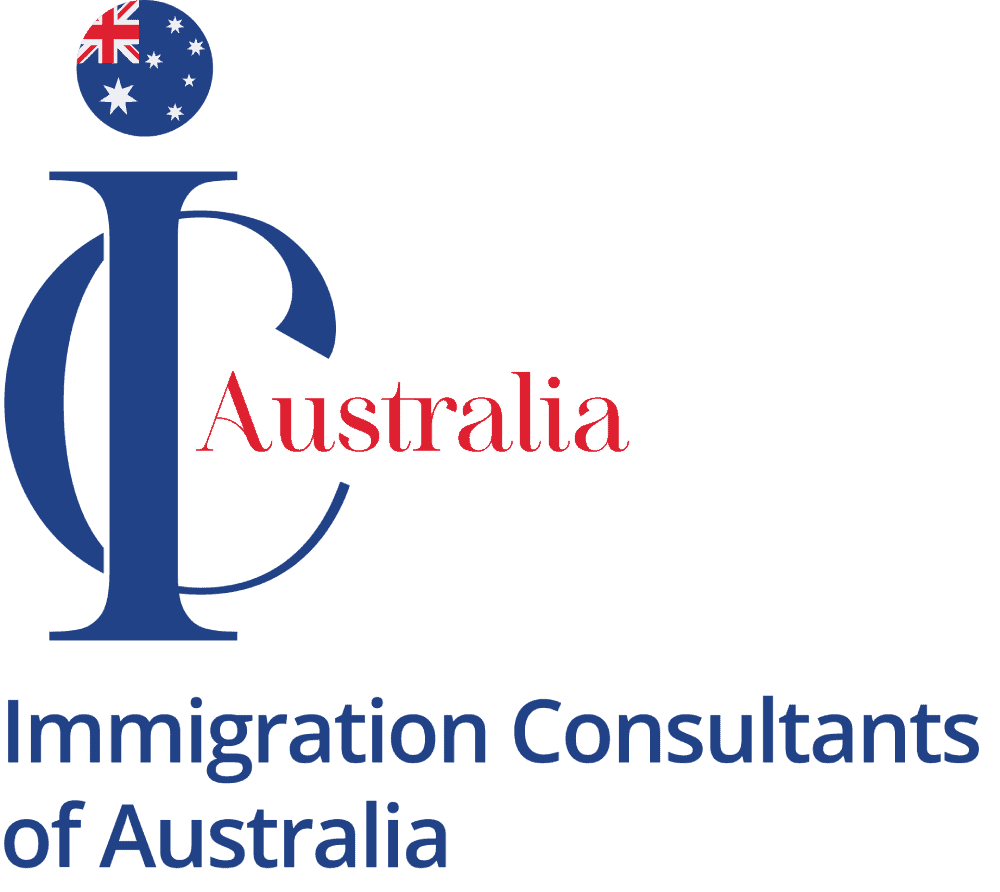

Timeline for Obtaining an Australian Visa: What to Expect
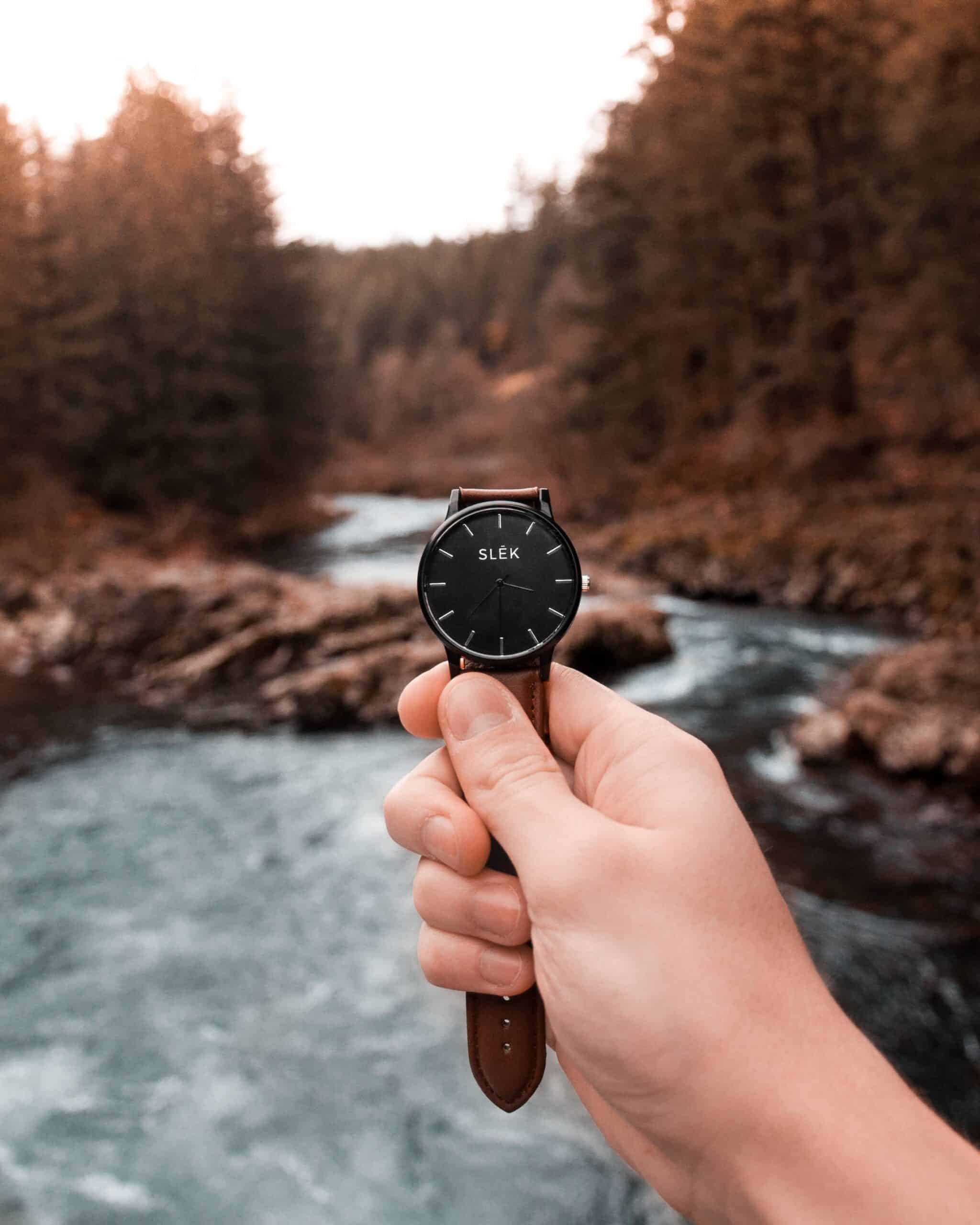
Are you considering a trip Down Under? Planning to work , study , or holiday in Australia? Understanding the visa application process is vital to make sure you experience a smooth journey from the application stage to the final visa approval. In this article, we will guide you through the timeline for obtaining an Australian visa, outlining how long the immigration process to Australia take.
Different types of visas and how long the immigration process to Australia takes
Australia offers a wide range of visas to cater to various purposes, including tourism, work, study, and family migration. Before diving into the visa application process, it’s important to understand the different types of visas available and how long the immigration process to Australia takes for each subclass. Each visa has specific eligibility criteria and requirements, so choosing the right one is crucial. Here are some of the most common types of Australian visas:
Tourist Visa
If you’re planning a short-term visit for holidays, sightseeing, or visiting friends and family, a tourist visa (subclass 600) is the way to go. This visa allows you to stay in Australia for up to three, six, or twelve months, depending on your circumstances.
Skilled Visa
You may be eligible for a skilled visa if you possess certain skills and qualifications that are in demand in Australia. The Skilled Independent visa (subclass 189) and Skilled Nominated visa (subclass 190) are popular options for skilled workers who want to permanently live and work in Australia.
Student Visa
Planning to study in Australia? A student visa (subclass 500) is a must. This visa allows you to enroll in a registered course and stay in Australia for the duration of your study program.
Partner Visa
If you’re in a genuine and ongoing relationship with an Australian citizen, permanent resident, or eligible New Zealand citizen, you may be eligible for a partner visa. This visa allows you to live and work in Australia indefinitely.
Working Holiday Visa
If you’re between 18 and 30 years old and want to explore the Australian way of life while working part-time, a working holiday visa (subclass 417) or work and holiday visa (subclass 462) might be the perfect fit for you.
These are just a few examples of the many visas available. It’s important to identify the visa category that best suits your purpose and circumstances before proceeding with the application process.
Choosing the right visa for your needs and timeframe
Selecting the right visa is essential to ensure a successful application. Consider the purpose of your visit, the duration of your stay, and your future plans in Australia. Here are a few factors to consider when choosing a visa:
Determine the reason for your visit. Are you visiting for tourism, work, study, or to be with a partner or family member? Each visa has specific conditions and requirements related to the purpose of the visit.
Consider the length of time you intend to stay in Australia. Some visas have maximum stay limits, while others allow for longer stays or even permanent residency.
Eligibility
Assess your eligibility based on factors such as age, skills, education, health, and character requirements. Some visas have specific skill or English language proficiency requirements that you need to meet.
Future plans
If you have long-term plans to live, work, or study in Australia, choose a visa that aligns with your future goals. Some visas offer pathways to permanent residency or citizenship, while others are temporary in nature.
It’s always a good idea to seek professional advice from ICAustralia to ensure you choose the right visa for your needs and understand how long immigration to Australia take.
Understanding the application process and how long immigration to Australia takes
Now that you have identified the type of visa you need, it’s time to dive into the visa application process. The process can vary depending on the type of visa and your individual circumstances, but there are some general steps that are common to most visa applications. Let’s take a closer look at the typical visa application process:
Research and gather information
Start by researching the visa requirements, eligibility criteria, and necessary documentation. Familiarize yourself with the application process and any additional steps specific to your chosen visa category.
Complete the application form
Fill out the online application form accurately and provide all the required information. Double-check your entries to avoid any errors or omissions that could delay the processing time.
Prepare supporting documents
Collect and organize all the supporting documents required for your visa application. These may include identification documents, proof of financial capacity, health and character certificates, and any other specific documents relevant to your visa type.
Submit your application
Once you have completed the application form and gathered all the necessary documents, submit your application online through the official Australian Department of Home Affairs website. Pay the applicable visa application fee at this stage.
Biometrics and health checks
Depending on your visa type and country of residence, you may be required to provide biometric data (such as fingerprints) and undergo a health examination. Follow the instructions provided by the Australian Department of Home Affairs regarding these additional requirements.
Visa processing time
After submitting your application, the visa processing time begins. The processing time can vary depending on the visa type, the number of applications being processed, and other factors such as your country of residence. It’s important to note that processing times are estimates and can fluctuate.
Visa decision
Once your application has been processed, you will receive a decision regarding your visa application. If approved, you will be granted a visa, and the details will be provided to you. If there are any issues or additional requirements, you may be contacted by the Department of Home Affairs for further information.
How long does it take to process an Australian visa?
The processing time for an Australian visa can vary depending on several factors, including the type of visa, the number of applications being processed, and your individual circumstances. While the Department of Home Affairs provides estimated processing times, it’s important to note that these are subject to change and should be used as a rough guide. Here are some general estimates for how long immigration to Australia takes:
The processing time for a tourist visa (subclass 600) can range from a few days to a few weeks, depending on the volume of applications received.
The processing time for a student visa (subclass 500) typically takes around four to six weeks, although it may vary depending on factors such as the educational institution and country of residence.
Skilled visas (subclass 189 and 190) generally have longer processing times due to the comprehensive assessment of skills and qualifications. Processing times can range from several months to over a year, depending on the demand and complexity of the application.
Partner visa processing times can vary significantly, with waiting periods of up to two years or even longer in some cases.
It’s important to plan your visa application well in advance, taking into account the estimated processing times and any potential delays that may arise.
Factors that can affect how long immigration to Australia takes
While the processing times provided by the Department of Home Affairs give a general how long immigration to Australia takes, there are several factors that can impact the processing time of your visa application. Here are some factors to consider:
Peak seasons and holidays
During peak travel seasons or holiday periods, such as Christmas and New Year, the volume of visa applications can increase significantly, leading to longer processing times. It’s advisable to submit your application well in advance to avoid potential delays.
Application completeness
Incomplete or incorrect applications can result in delays as the Department of Home Affairs may request additional information or clarification. Ensure that all required documents are provided and your application is complete before submission.
Additional checks and verifications
Depending on your individual circumstances, additional checks or verifications may be required. This can include character checks, health assessments, or verification of submitted documents. These additional steps can prolong the processing time.
Country-specific requirements
Some countries have specific requirements or agreements with Australia that can impact processing times. These requirements may include additional documentation or checks that need to be completed, leading to longer processing times.
Changes in legislation or policy
Changes in immigration legislation or policy can impact visa processing times. It’s important to stay updated with any changes that may affect your application.
While you cannot control all these factors, being aware of them can help you set realistic expectations and plan your visa application accordingly.
Tracking How Long Your Visa to Australia May Take
Once you have submitted your visa application, you may be eager to track its progress. The Department of Home Affairs provides various options for tracking your visa application. Here are some methods you can use to understanding how long your visa to Australia may take:
Online tracking
The most convenient way to track your visa application is through the Department of Home Affairs’ online portal. You can log in using your unique application reference number and password to check the status of your application.
Email updates
If you provide your email address during the application process, you will receive email updates regarding the progress of your visa application. These emails will inform you of any important updates or requests for additional information.
Contacting the Department of Home Affairs
If you have any urgent queries or concerns about your visa application, you can contact the Department of Home Affairs directly. They will be able to provide you with the most up-to-date information regarding your application status.
It’s important to note that visa processing times can vary, and it’s not uncommon for applications to take longer than initially estimated. Patience is key during this stage, and it’s advisable to avoid making any travel arrangements until your visa has been approved.
Understanding how long a visa to Australia takes and final tips for a successful application
Obtaining an Australian visa can be an exciting and rewarding process, but it requires careful planning and attention to detail. By understanding the timeline for obtaining an Australian visa and following the steps outlined in this article, you can navigate the application process with confidence. Here are some final tips to ensure a successful visa application:
Start early
Begin your visa application process well in advance to allow for any unexpected delays or additional requirements.
Familiarize yourself with the visa requirements, eligibility criteria, and necessary documentation for your chosen visa category.
Be organized:
Keep all your documents and information organized to ensure a smooth application process. Create a checklist to help you stay on track.
Double-check your application:
Review your application form and supporting documents for any errors or omissions before submission.
Seek professional advice:
If you’re unsure about any aspect of the visa application process, consult a registered migration agent or seek professional advice to ensure you have the best chance of success.
Ready to live in Australia? Seek assistance from ICAustralia! We simplify the application process and increase your chances of success. Additionally, we guarantee a smooth and successful immigration experience to Australia by crafting a personalized immigration plan that aligns with your unique profile and aspirations. Additionally, we offer comprehensive assistance, guidance from a regulated MARA agent, and manage the application submission process on your behalf.
Living in Australia can be your reality in 2024. Start your Australian dream by contacting ICAustralia today!
Your Immigration Process Starts Here!
Australian visa processing times: How long you’ll wait for approval

- Citizenship
- Immigration
- Study Abroad
The Aussie immigration system is complex, application fees are expensive, and in some cases, visas can take over two years to be processed. Here's how long you can expect to wait when applying for an Australian visa.
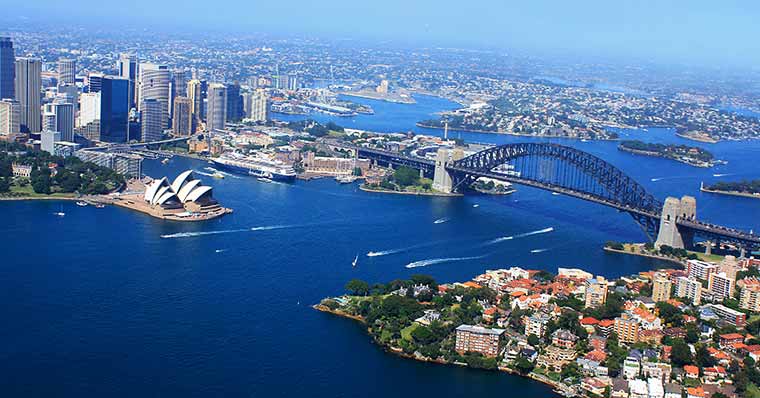
Jun 27, 2019 by Telerik.Sitefinity.DynamicTypes.Model.SableTeamMembers.Member
Visa processing times
The Australian government updates the processing times monthly. Factors such as application volumes, seasonal peaks and complex cases may also affect how long it takes to approve your visa.
*Processing times are updated monthly and were correct at time of publishing.
See also: An Australian visa for South Africans over 45
Circumstances that affect your visa application processing times
Applications are assessed on a case-by-case basis and processing times given by Australian Home Affairs may change due to individual circumstances. Some of the most common situations that could affect how long it takes to process your visa include:
- Whether you have filled in the application form accurately
- Whether you have provided and completed all the necessary documents
- How long it takes officials to perform the required checks on the information provided
- How long it takes to receive additional information from external agencies
See also: Up your pay Down Under: Plumbers and electricians needed in Australia
Get the right visa, get to Australia
If you want to move to Australia, you’ll first need to determine which visas you qualify for and then decide which one suits your individual circumstances and long-term plans. Australia offers various visas for people who have skills that are in demand, businessowners, partners and dependants.
In November 2019, the Australian government will be launching two new Skilled Regional Provisional visas for skilled migrants. Since there is a very high demand for skilled individuals in regional Australia, visas in the Migration Programme will receive priority processing.
Have a question about which Aussie visa is right for you?
Get your application approved without any hiccups.
Applying for an Australian visa without the correct guidance can lead to wasted time, money and delay your application. One way to ensure your application is processed as smoothly as possible is by speaking to a M ARA-registered immigration advisor before you apply. This will ensure you don’t experience any unnecessary delays or extra costs. An immigration agent can also advise you on which visa route is the best one for you and your family.
Ready to pack your bags and head to Australia? Speak to us about your options at [email protected] or call us on +61 (0) 38651 4500 .
We are a professional services company that specialises in cross-border financial and immigration advice and solutions.
Our teams in the UK, South Africa and Australia can ensure that when you decide to move overseas, invest offshore or expand your business internationally, you'll do so with the backing of experienced local experts.
How and When to Get a Visa to Visit Australia

Update: Some offers mentioned below are no longer available. View the current offers here .
US citizens can travel to many countries visa-free, but Australia isn't one of them. If you're thinking about traveling to Australia, you'll need to plan ahead and obtain valid travel documentation. Here's what you need to know before traveling to Australia as a US citizen with a US passport.
What Visa Do I Need?
The Australian government makes it easy to determine the visa you need with its Visa Finder website . This website asks three questions, the first of which is about the purpose of your trip (think: vacation, visiting relations, attending an event, doing business and seeking medical treatment, among others):
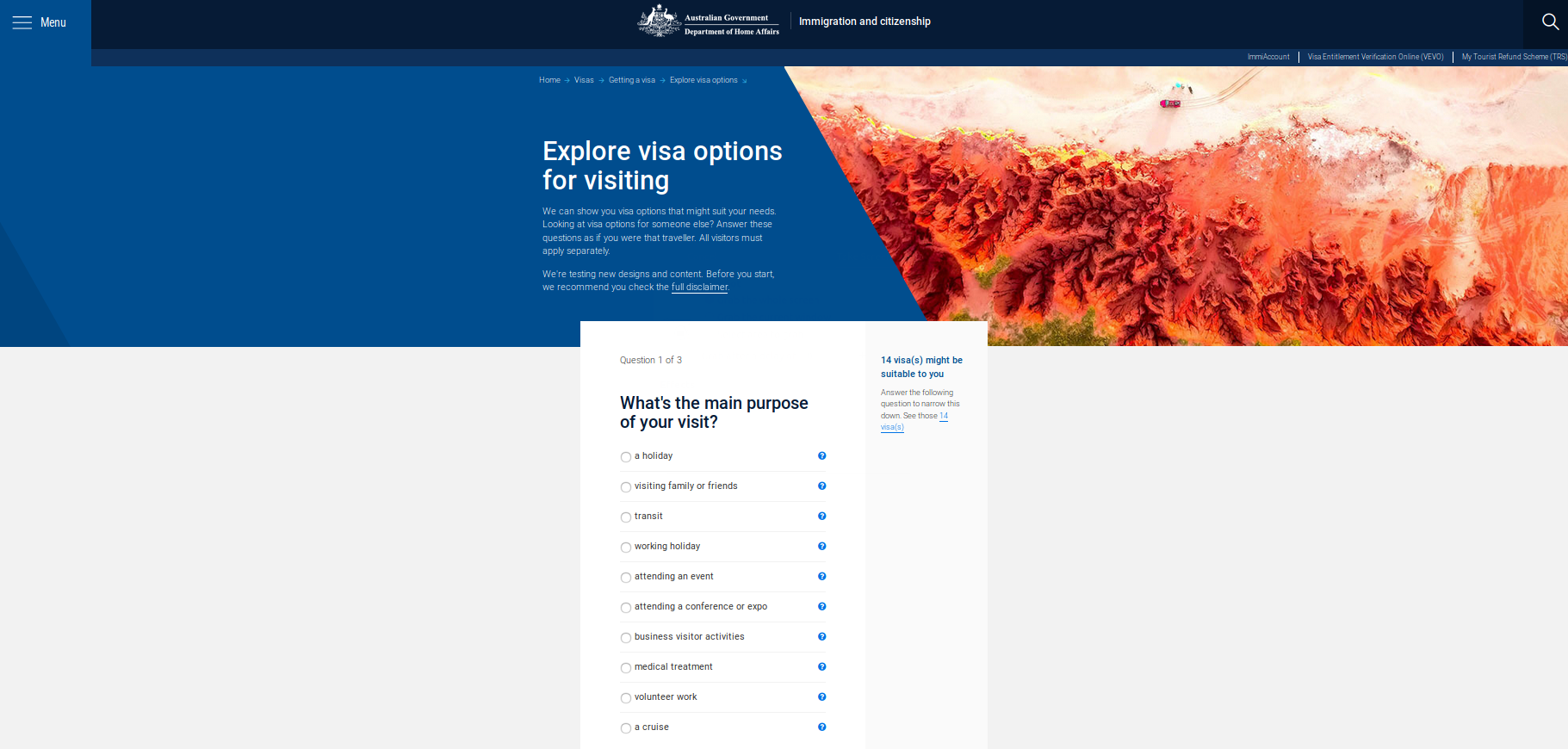
The next question asks the country of your passport:
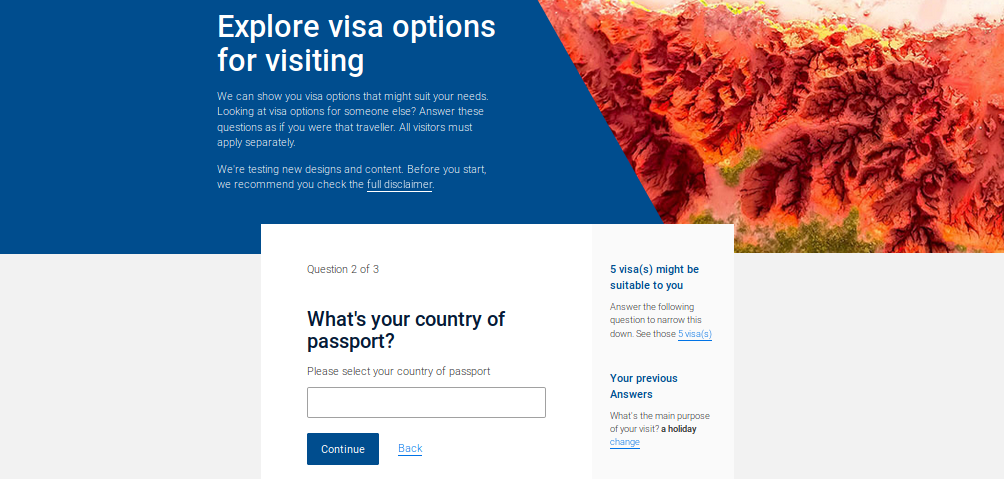
And the final question asks how long you'd like to stay in Australia — either less than or more than three months.
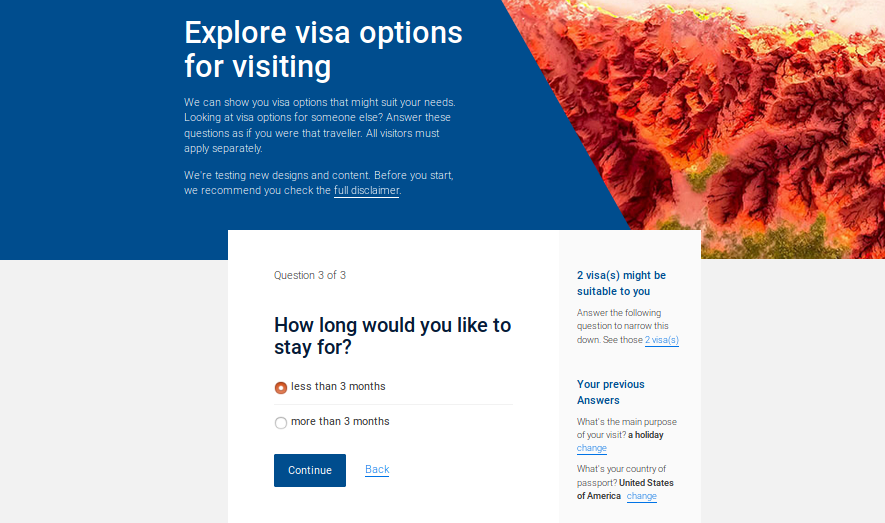
Most travelers from the US will likely be eligible for an Electronic Travel Authority (Subclass 601) — also called an ETA — as I was for my most recent month-long trip.
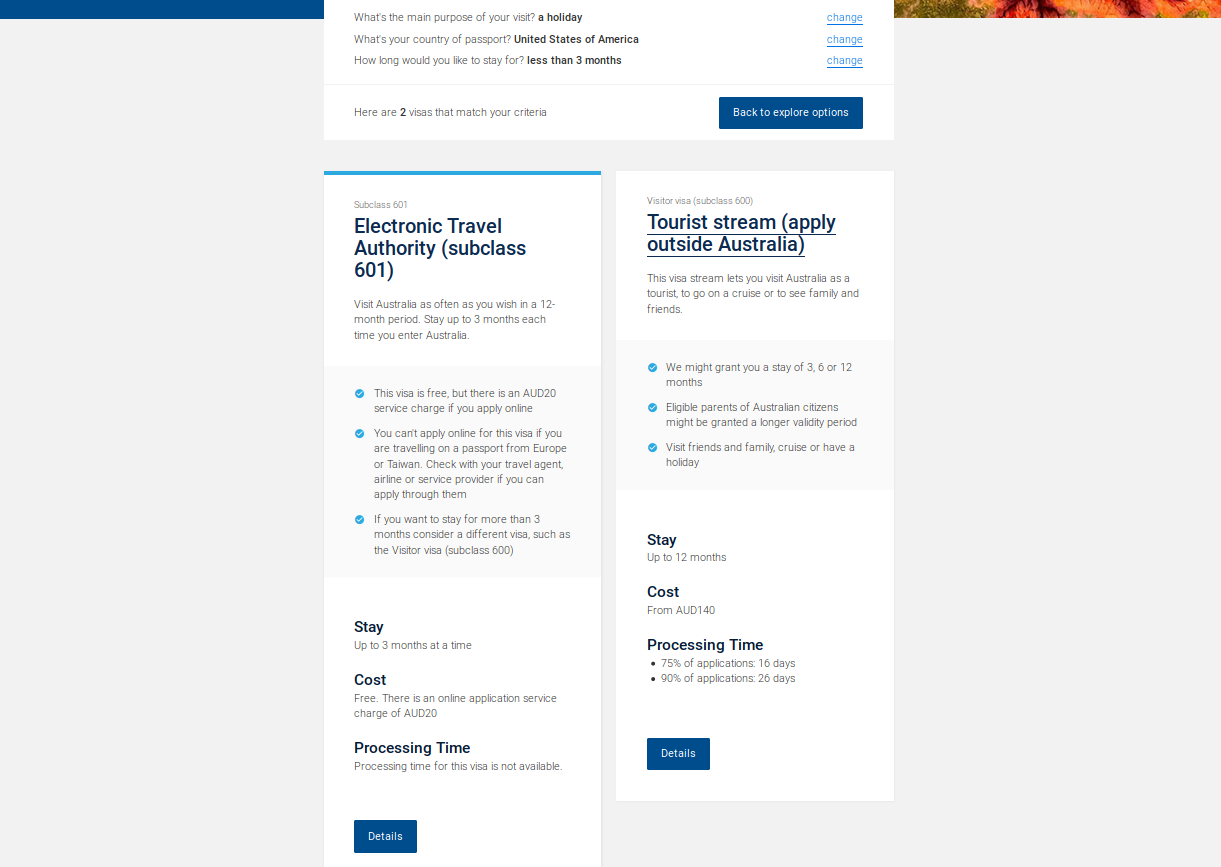
This is because an ETA is available to US citizens visiting Australia for three months for reasons that fit into the following categories:
- Holiday or vacation
- Visit to see friends or family
- Select business activities such as general business or employment inquiries; investigate, negotiate, sign or review a business contract; or attend a conference, trade fair or seminar
Since most US citizens traveling to Australia will be traveling for one of these reasons (and, as a result, are eligible to apply for an ETA) I'll focus on ETAs available to US citizens with a US passport.
What Are the Requirements?
To apply for an ETA, you must:
- Have a valid passport from an eligible country (including the US).
- Apply while outside Australia.
- Wish to stay no longer than three months at a time (you must not study for more than three months, for example).
- Be free from tuberculosis.
- Not have any criminal convictions for which you have been sentenced for a total combined period of 12 months or more, whether or not you served the sentence(s).
- Have paid back any debt — of either yourself or your family — or arranged to pay back any debt to the Australian government.
How Much Does It Cost to Apply Online?
The ETA is free, but there is an online application service charge of 20 Australian dollars (about $14) per applicant. As US passport holders -- along with seven other nationalities -- must apply online, there's no escaping the online application service charge. The fees for my recent ETA applications coded as "Bills and Utilities" on my Chase Sapphire Reserve statement, so don't expect the fee to code as "Travel."

How Long Does It Take?
The Australian government says "processing time for this visa is not available" and that the visa may take longer to process if:
- You don't fill it out correctly
- It takes the Australian government additional time to verify your information
Most ETA applications are approved immediately, and those that need additional processing are usually handled within 24 hours. This being said, the Australian government recommends travelers get an approved ETA before booking any nonrefundable travel. Once an ETA is granted, it is valid for one year and allows multiple entries up to three months each.
How Do I Apply?
The online ETA application takes about five minutes to complete. To start an application, click "Apply for an ETA."
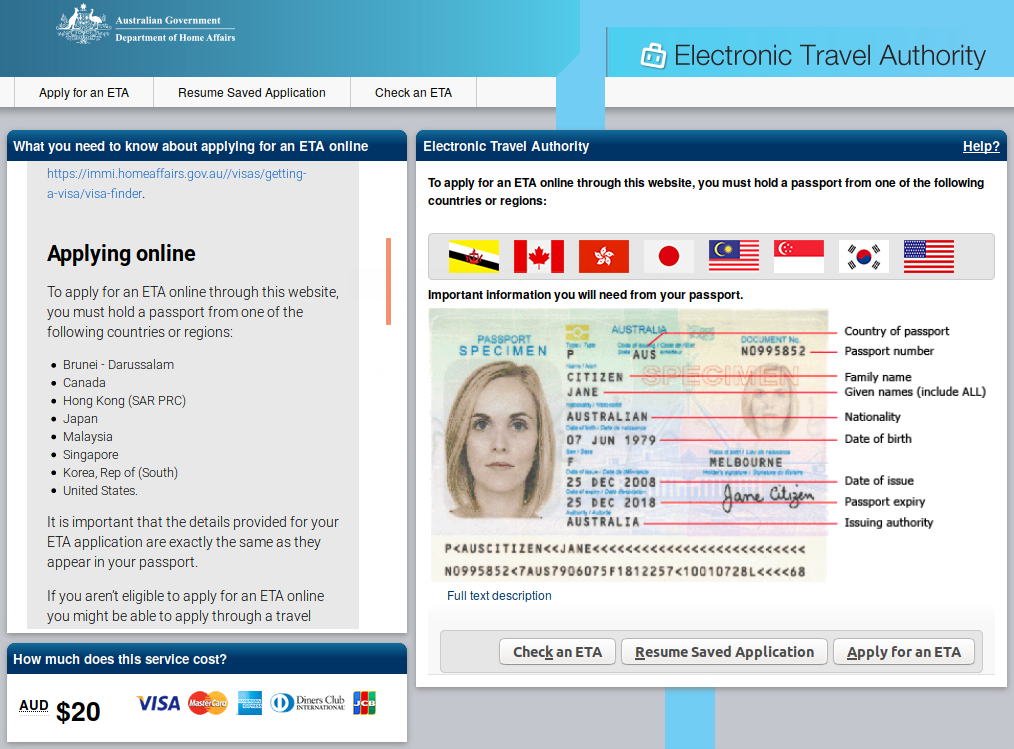
Step 1 : Select whether you need a Tourist ETA or a Business Visitor ETA, and certify that you are currently located outside Australia.
Step 2 : Enter your personal details, whether you have an alias, answer a question about your criminal record and enter your passport information.
Step 3 : Enter your address, phone number and email. Select whether you wish to receive communications by SMS and declare whether you hold any passports issued by other countries.
Step 4 : Confirm your information.
Step 5 : Pay the online service charge of 20 Australian dollars (about $14) using a credit card.
How Do I Check My Status?
Once you have submitted an online ETA application, you'll receive a response. The response may:
- Notify you that your ETA has been granted.
- Advise you that your application has been referred for further assessment. You can then check the status of your application after 12 hours by logging back into the ETA system and selecting the option "Check an ETA."
- Advise you to contact the nearest Australian visa office to make a new application.
My response came immediately in an email titled, "ETA Application for Australia [CLIENT-IN-CONFIDENCE] (PROD)" that confirmed my application had "been successful," my payment had been received, that I was now the proud holder of a "valid ETA for Australia" and that my ETA had been linked to my passport, so no additional documents would be required during the travel process.

What Do I Need to Print Before Travel?
Nothing. When your ETA is linked to your passport, it becomes available to both airline representatives as well as Australian immigration authorities. So, there's no need to print your confirmation once your ETA has been granted.
Other Questions
If you have other questions about ETAs, or other types of Australian visas, take a look at the Australian government's Visa Finder website . Questions such as how to combine multiple visa types if the purpose of your trip changes and what to do if you get a new passport are covered on the website.
Traveling to Australia soon? Here are some TPG articles that might be helpful:
- The Best Ways to Use Points and Miles to Fly from the US to Australia
- TPG Readers Reveal Their Favorite Points Hotels in Australia
- TPG Readers' Best Tips for Flying Around Australia
- 8 Australian Islands You Probably Haven't Heard of But Need to Visit

Tourist visa to Australia for US Citizens
Key aspects.
Cheapest and fastest visa for touristic purposes.
Visa Duration
12 months total, up to 90 days each visit .
Approval time
95% of tourist visas are granted within 24 hours .
If you are planning a visit to Australia for holiday, as a US citizen you will need an Australian tourist visa (also known as “Australian vacation visa”) .
A tourist visa for Australia is technically type of ETA (Electronic Travel Authority) visa: a visa that you simply apply for online without having to fill in a paper form or send in your passport to any embassy. This is why a touristic ETA permit is sometimes referred to also as “electronic tourist visa” or “e-tourist” visa : filling the Australian tourist visa form directly online is all there is to do .
To be able to apply for an Australian Tourist Visa you must be travelling to Australia for holiday or for visiting friends or family, and hold a valid passport.
In-depth information on Australian Tourist Visas
- Tourist Visas for Australia for American Citizens
- Australian Tourist Visa: How to Apply
- Tourist Visa Requirements for Americans
- Process and Processing Time of Australian Tourist Visas
- Duration and Validity of an Australia Tourist Visas
Types of Australian Tourist Visas (Alternatives to Australian Touristic ETA)
Re-entry, renewal and extension of australian tourist visas, working in australia with a tourist visa, getting married in australia on a tourist visa, australian tourist visa: costs and fees, tourist visas for australia available to american citizens.
A standard Australian tourist visa ( Electronic Travel Authorization ) authorizes visits of up to three months at a time and is valid for 12 months after the date of issue. Unlike traditional visas, there are no paper applications to complete, and you will have no visa labels or stamps in your passport. Instead, your tourist visa for Australia will be electronically attached to your passport.
United States’ citizens can apply for a tourist visa to Australia using their passport , and the passport number will then be linked to the visa. If you lose your passport or it is stolen before you enter Australia, you will need to re-apply for a new vacation visa.
Apart from the standard ETA tourism visa, there are a few more specific tourist visa types one can request in order to travel to Australia as a tourist: if you feel an ETA does not satisfy your needs, you will need to determine the most appropriate visa for you among other visa options.
The most common short-stay tourist visa types for Australia are:
- Electronic Travel Authority (ETA) – formally known as Australian Visa Subclass 601
- Work and Holiday Visa – formally known as Australian Visa Subclass 462
- Tourist stream – formally known as Australian Visa Subclass 600
Online Tourist Visa for Australia (ETA e-Tourist)
An e-tourist visa, which is also called an ETA, is a subclass 601 visa . You can use this visa to tour Australia, visit family or friends or study or train for short-term. Business visitors can also use this visa for short-term. An ETA tourist visa is a temporary visa that is valid for 12 months from the date of issue, and it is a multiple entry visa. For each entry, you can stay up to 3 months.
You can enter and leave as many times as you want as long as it is valid. However, the ETA cannot be extended: you must get another Australian tourist visa if you want to extend your holiday or stay longer for other reasons. U.S. passport holders who are planning trips shorter than 90 days are almost always immediately eligible for electronic tourist visas (ETAs) , which will be electronically matched to the traveler’s passport in the Australian immigration official databases.
More info on Online Tourist Visas for Australia (ETA) – updated for 2024:
- Both passport holders and travel agents can apply for ETAs.
- Overstaying a short stay tourist visa in Australia could lead to exclusion, detention and removal. If you plan to stay in Australia longer than 3 months per entry, please make sure you apply instead for the Long Term visa, subclass 600.
- Once you have your online tourist visa for Australia, you can use your e-passport at the SmartGate system when you arrive in Australia.
If you are not sure what tourist visa to apply for, we recommend you apply for this kind of visa .
Tourist Stream (Subclass 600)
The Tourist Stream visa is an alternative to the ETA tourist visa, but typically slower . Getting this holiday visa for Australia, you can visit family and friends, travel the country, and study or train for up to 3 months. This visa may be valid for between three months and 12 months, and you can request it for single entry or multiple entries. You can enter and leave as often as you want as long as the Tourist Stream is valid, but you may not stay more than 12 months during 18 months. This visa is also typically more expensive than an ETA and takes longer to process . Also, immigration office can request more documents from the applicant, for example a scanned copy of passport ID page or bank statement. In general, whenever possible we recommend applying for a Tourist ETA, for a faster – 100% online – visa release process.
Work and Holiday Visa Subclass 462
Getting a tourist visa for Australia also allowing you to work is possible: this is what an Australian Work and Holiday Visa is for , as this permits allows you to work during your stay in Australia, and to travel to and from Australia as many times as you want while working or studying.
With a work and holiday visa (often referred to also as “working holiday visa”) you can have the freedom to work to pay for your holiday, or study for up to 4 months . It is a temporary visa that is valid for up to 12 months from the date you enter the country. It cannot be extended. You can remain in the country up to 12 months, and you can leave and enter Australia as often as you like. Read more about work and holiday visas for Australia .
- Apply for WHV now
Additional type-independent Australian Tourist Visa Information:
- Regardless of the type of 2024 Australian tourist visa or ETA you need, it is highly recommended that you get health insuranc e to protect you during your time in Australia. You will be responsible for any healthcare costs that you incur while you are in Australia, and proper insurance coverage will help reduce your financial liability.
- Visas are electronically linked to your passport. There is no need for stamps or labels .
- Simplify the process by applying for your ETA tourist for Australia directly online as soon as possible .
Australian Tourist Visa for US Citizens: How to Apply
U.S. citizens need visas to travel to Australia. An Australian tourist visa requested from the USA via Electronic Travel Authorization will allow you to enter Australia for up to 90 days at a time for a year from the date of issue. After the first visit, subsequent visits are at the immigration officer’s discretion.
Getting a Tourist Visa to Australia from the USA
In order to get a tourist visa to Australia from USA you must have a valid passport (valid for at least 6 months upon entering Australia in order to comply with the requirements of most airlines flying to Australia – even though not strictly required by Australian Immigration Office) and obtain your US tourist visa to Australia before arriving in the country.
You may also need to complete a medical exam depending on your condition (any medical requirement – if needed – will be specified during the online application process). Visitors may also need to provide financial information upon request to receive their tourist visa. Also in this case, any requirement – if needed – will be specified during the online application process .
It is easy to apply for a tourist visa to Australia from the USA online: simply choose the right visa for your needs and follow the instructions on-screen. Most visa requests are processed and approved instantly .
Australian Tourist Visa Requirements for Americans
The conditions and eligibility for visas can vary based on the type of visa. Most U.S. citizens are eligible for ETAs as long as they hold valid passports.
US Passport Validity and Photo Requirements
We strongly recommend that your US passport be valid for at least 6 months upon entering Australia . This is why if your passport is due to expire soon or during the time you will be travelling, you may need to get a new passport before applying. Australian tourist visa photo requirements are similar to passport photos. Please ensure your photos are accurate and current.
Documents Required to US Citizens for an Australian Tourist Visa
The document checklist can vary based on the type of visa requested: with an ETA, you will only need your passport, and the ETA permit will be electronically attached to your passport.
For other visa types, you may be asked for other identification, including the biographical pages of your passport, travel documents and the IDs of your fellow travelers. Other required documents may be requested if authorities are not satisfied as to your identity.
Funds Required for an Australian Tourist Visa
When travelling to Australia, you may be required to show proof of funds. This can include displaying a minimum bank balance on your bank statement, audits, taxation records or other proof of satisfactory employment and income. After the application is processed, in the rare case a bank statement is required by Australian Immigration in order to verify your bank balance, an immigration officer will contact you .
Medical Requirements for an Australian Travel Visa
If you are applying for a non-ETA Australian visa and plan on staying in Australia for more than 6 months, you might be required to complete a health check and a chest X-ray. This can extend your visa application process up to 20 days. You are more likely to be required to complete a medical test if you are from a high-risk area or are over 75. In these cases, Yellow Fever is the only vaccination requirement.
Australian Tourist Visa Age Limits for American Citizens
For US passport holders willing to travel from USA to Australia there is no age limit on tourist visas . Of course, anyone who is travelling to Australia without an Australian passport will need a visa on arrival – and for a child under 18, the ETA will be based on the child’s passport. This means children will need separate ETAs, using details from their passports (children who are on their parents’ passports also need their own ETAs, but the information from their parents’ passport will be used).
Process and Processing Time for Australian Tourist Visas
Visa processing time for an australian eta tourist visa (subclass 601).
The Electronic Travel Authority (ETA) is the most commonly used Australian Tourist Visa. The process can be completed online and requires no extra application forms, no visa labels and no passport stamps.
To be eligible for and maintain your instant Australian tourist visa, you must abide by specific conditions, including – in order:
- Being free of criminal convictions
- Passing a health check as required
- Departing within the required time period
- Not working during your time in Australia
- Not engaging in study or training for more than three months
In general, the Australian tourist visa processing time for a Tourist Stream Visa (Subclass 600) can take from 48 hours to more than a month . A Tourist ETA though – which is the most common type of tourist visa – has a much lower estimated waiting time, as it is much faster to process. An ETA e-visa for tourists can often be requested and issued just days before your planned visit . It is a 100 percent secure, paperless process, and the visa will be electronically linked to your passport just moments after it has been issued.
However, we always recommend to request your Touristic ETA Visa at least a few weeks before departure , to avoid any risk. Don’t worry though – with an ETA, you can also track your application online via an online tracking system.
Australian Tourist Stream Visa (Subclass 600) Processing Time
The amount of time taken for an Australian tourist visa to be processed can vary based on how promptly you supply the supporting documents, your response to requests for further information, how long it takes to verify your information and peak processing times.
Also, the Australia tourist visa process is quite straightforward:
- Check that your current U.S. passport is valid.
- Apply for your visa.
- Wait for verification of receipt.
- Wait for notification of your status.
If the Australian tourist visa procedure was successful, you will be granted a visa. You can keep track of your progress using the online Australia tourist visa tracking system.
The maximum processing time for a conventional Australian tourist visa (Subclass 600) is about a month , with the waiting time ranging from 20 to 33 days in the vast majority of cases. For fast-tracked visas or ETAs, the waiting time can be mere minutes or days, especially if you have all the necessary documentation to complete the verification time.
Finally, as far as Work and Holiday Visa Processing Times are concerned, we recommend you check the dedicated page on this site .
Duration and Validity of an Australia Tourist Visa
Tourist visas are valid for varying periods of time, depending on the type of visa.
The ETA is a 12-month tourist visa . It is a popular visa, but it is limited regarding the length of stay and only allows visitors to remain in Australia for 3 months or 90 days at a time . You can enter as often as you like as long during the one year the tourist visa is valid.
For a visit of longer duration or if you want to stay more than 3 months during any period, you will need a different Australian visa. The tourist visa stream (Subclass 600) has a length and duration that can vary based on the purpose of the stay. In most cases though, Australian tourist visa validity lasts at least 12 months .
As an example, the Australian e600 visitor visa is a 6-month tourist visa for Australia. It also allows you to stay in the country up to one year depending on the reasons for your visit. You can also enter and leave the country as needed as long as the visa is valid.
The subclass 870 visa instead is a longer-term 3-year tourist visa specifically designed for parents. With it, parents can stay in Australia for 3 or 5 years and no more than 10 years. This allows them to enter and re-enter Australia as needed to visit their stepchildren, adopted children or biological children more conveniently and affordably.
Whether you are planning an Australian trip that lasts 2 weeks, 90 days or even a year, there is a visa designed to suit your purpose. Check and apply online to find the right one for you or to explore samples of tourist visas.
There are several types of tourist visas in Australia that may apply if you do not qualify for a Tourist ETA or if the ETA does not suit you needs, such as a work and holiday visa or other types of Australian visas for tourism. Here they are:
Australian Work and Holiday Visa
Australian Tourist Stream Visa (Subclass 600 – Application form 1419)
The Australian tourist visa stream Subclass 600 (to which people apply using form n.1419) is a 6-month tourist visa for Australia. It also allows you to stay in the country up to one year depending on the reasons for your visit. You can also enter and leave the country as needed as long as the visa is valid.
Australian Visiting Academic Visa
The former Australia Tourist Visa 419 is closed to new applications for 2024 . However, the Tourist Visa Subclass 408 may be an alternative. This visa, which is also called the Temporary Activity Visa, allows you to participate in special approved programs, including:
- Gap year volunteer work
- Cultural enrichment programs
- Youth exchanges
- Community programs
- School language assistants
This visa is valid for up to 12 months.
Australia Tourist Visa 771 (Australia Transit Visa)
Also known as the Australian Transit Visa, this visa allows people to spend up to 72 hours in Australia to “pass through”. With this visa, you may not spend more than 72 hours in the country.
Here are some of the most frequently asked questions about re-entering Australia with a tourist visa, about extending your stay in Australia as a tourist or about renewing your tourist visa while you are in Australia.
Is the Australian tourist visa multiple entry?
The Australian ETA is good for 90 days at a time, also allowing multiple-entries . This means that within one year sinve when the ETA Tourist visa has been issued you can enter, leav and re-enter Australia as many times as you wish – as long as each entry lasts a maximum of 90 days.
However, if your current visa is due to expire while you are still in the country, you will need to apply for an Australian tourist visa renewal, via a Long-stay tourist visa application .
What happens if I stay too long and my Australian tourist visa has expired?
Overstaying your stay with a tourist visa in Australia will result in your becoming an “unlawful non-citizen” – which can lead to detention and removal from the country. Worse, it could interfere with your ability to re-enter Australia on a tourist visa in the future. If you overstay your visa by more than 28 days, you could even become excluded and prevented from re-entering Australia on a tourist visa for as long as 3 years. Don’t do it.
Can I change my Australian visa once I am in the country?
No, you cannot change your visa type , such as an Australia tourist visa multiple entry, once you are in the country. However, you can apply for a further stay via the Long-Stay Tourist Visa, subclass 676.
What are my other options for extending my tourist visa?
Because the consequences of an Australia tourist visa overstay can be so serious, it is critical that you apply for a tourist visa renewal or extension as soon as possible and before your visa has expired . Applying online is fast and convenient.
- Extend your visa
If you are planning to travel to Australia with a ETA Tourst Visa, you must know that it is not legal to work with an ETA . ETA-visitors have no right to “work”. However, they can do volunteer work or engage in other business activities, such as business meetings, conferences or seminars . Of course, you can stay in Australia on your tourist visa while looking for work, but once you found it you should obtain a different kind of visa in order to legally maintain your work.
However, working on a “tourist visa” in Australia is fairly common – especially for those who wish to work to pay for their holidays. If you want to legally work in Australia during your holiday though you will need a special, dedicated visa – not an ETA. This visa is called “ Work and Holiday Visa ” (often referred to also as “Working Holiday Visa”).
You can do any kind of work or jobs while on a tourist visa in Australia. However, your Work and Holiday Visa must be used within one year of the date it is issued, and it will be active for 12 months from the date you enter the country.
A working holiday visa cannot be extended: if you choose to stay longer, you must apply for a new visa. Additionally, you cannot bring dependent children or other family members with you, and you must pay taxes from anything you earn during your tourist visa working days.
The cost for a work and holiday tourist visa is of $ 625.00 as of 2024, but additional costs may also arise, including costs for police certificates, biometrics and health checks. Processing time can take from 13 to 22 days but may take longer if more information is needed or for verification purposes. Private health insurance coverage is highly recommended during your stay in the country. Read more about Work and Holiday Australian Visas for US Citizens here .
- Apply for a WHV
According to Australia Marriage Law, you do not need to be an Australian resident to get married in Australia . You simply need the tourist visa (e.g. visa subclass 651) and you must file a Notice of Intended Marriage form along with any other requested documents .
If you are planning on getting married in Australia on a tourist visa, your celebrant can help ensure you meet all necessary requirements , including that you:
- Are not married to anyone else
- Are not marrying to a closely related family member
- Are at least 18 years old
- Freely consent to the marriage
Notice that if you plan to live in Australia after marriage, you might need to apply for permanent residency as needed .
In order to obtain your Australian Tourist Visa, you will need to pay an application charge when applying for your visa – plus all costs related to the visa release. The total Australia tourist visa cost can therefore vary based on the type of visa and when you apply. Both paper applications and e-visas such as ETA tourist visa costs must be paid online , and forms of payment accepted are credit cards and PayPal.
While there are no Australia tourist visa fees associated with the ETA, there is an online service charge of $ 69.00 .
The cost of a Work and Holiday visa is instead of $ 625.00 .
The visa application fee may change periodically: if the Australian immigration tourist visa fees increase between the date of the application and the date of the receipt, the new fee will apply.
Australian Government official resources:

Visa Traveler
Exploring the world one country at a time
Australia Visitor Visa: Requirements, Eligibility and Application Process
Updated: February 7, 2024
Australia Visitor Visa is the only option to visit Australia as a tourist for many nationalities. If you don’t qualify for either the Electronic Travel Authority(ETA) or the eVisitor Visa, then you will need to get a Visitor Visa.
Australia no longer accepts paper applications for the visitor visa. All applications must be lodged online through the Australian Government Immi Portal.
The Visitor Visa has subclass 600 in Australia’s visa documentation and the subtype we’re interested in is the “Tourist stream (apply outside Australia)”.
Quick summary:
- Eligibility: All nationalities are eligible
- Validity: Valid for 6 months, 1 year or 3 years with single or multiple entries
- Duration of stay: Generally, 3 months allowed stay, but up to 6 or 12 in some cases
- Visa fee: Visitors visa fee is 190 AUD
- Processing time: 50% of applications are processed in 7 days and 90% in 21 days.
If you haven’t already, read the Australia Visa Guide to familiarize yourself with Australian tourist visa types, requirements, eligibility and entry procedures at the border.
Table of Contents
Understanding australia visitor visa.
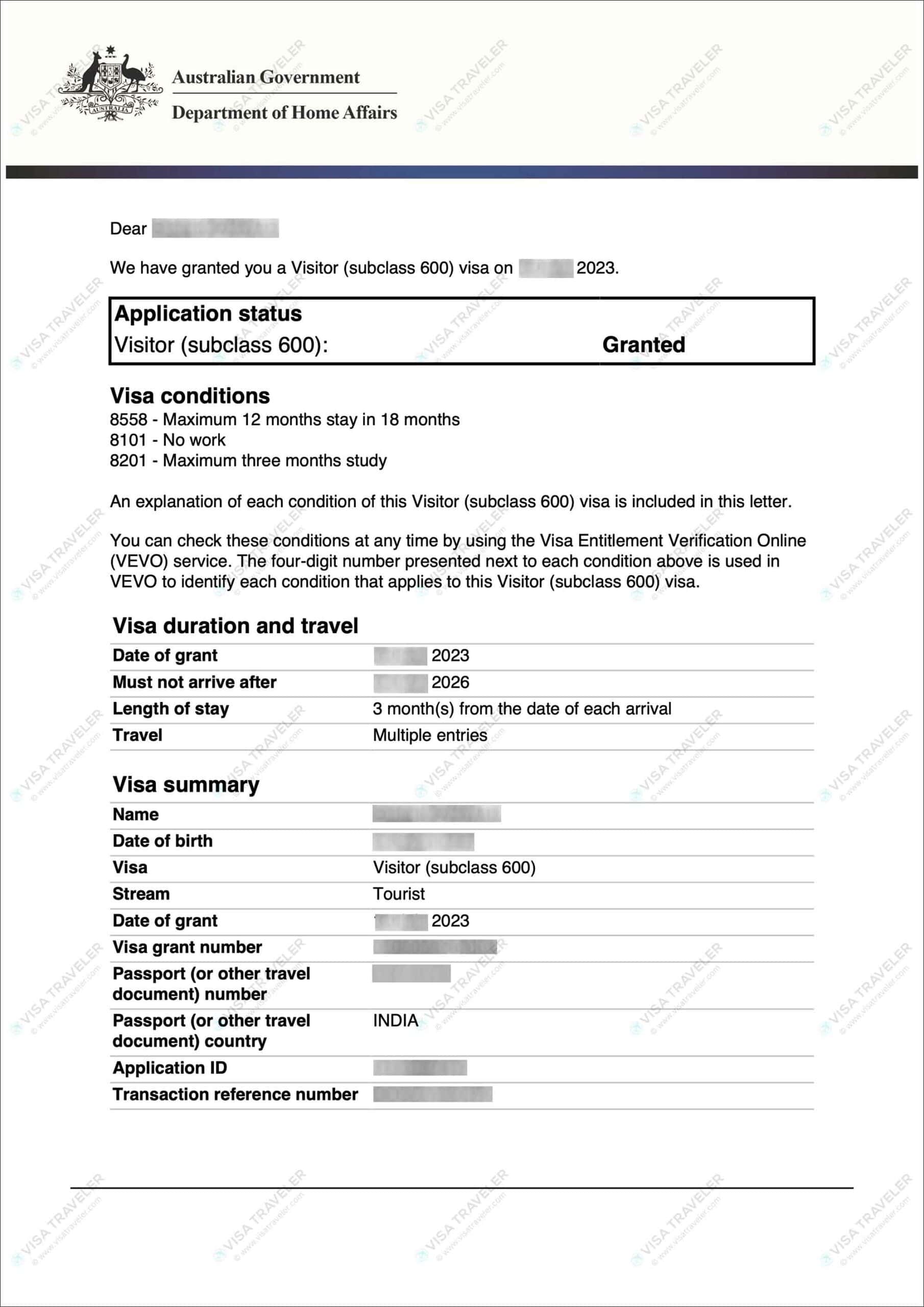
Visitor visa validity
The Australian Visitor visa is valid for 6 months, 1 year or 3 years from the date of issue. The validity of the visa depends on your nationality and circumstances. For example, most Indian passport holders get a 3-year valid Australian visa, whereas Phillippine passport holders get a 1-year valid visa. Pakistan nationals get a 6-month validity.
You must visit Australia within the validity of your visa.
Duration of stay
Most Visitor visas granted allow for 3 months of continuous stay in Australia. Depending on circumstances, you might be granted a stay of 6 months or even 12 months.
Allowed number of entries
Most Visitor visas are multiple-entry , but Home Affairs also issues single visas in certain circumstances for certain nationalities.
When to apply
Since the tourist visas are valid for at least 3 months, it’s a good idea to apply well in advance. Most applications get processed in 3 weeks or fewer.
Visa extension
Australia Visitor visa is non-extendable . If you need to extend your stay in Australia , you are allowed to apply for another Visitor Visa (onshore) from within the country.
Australia Visitor Visa Requirements
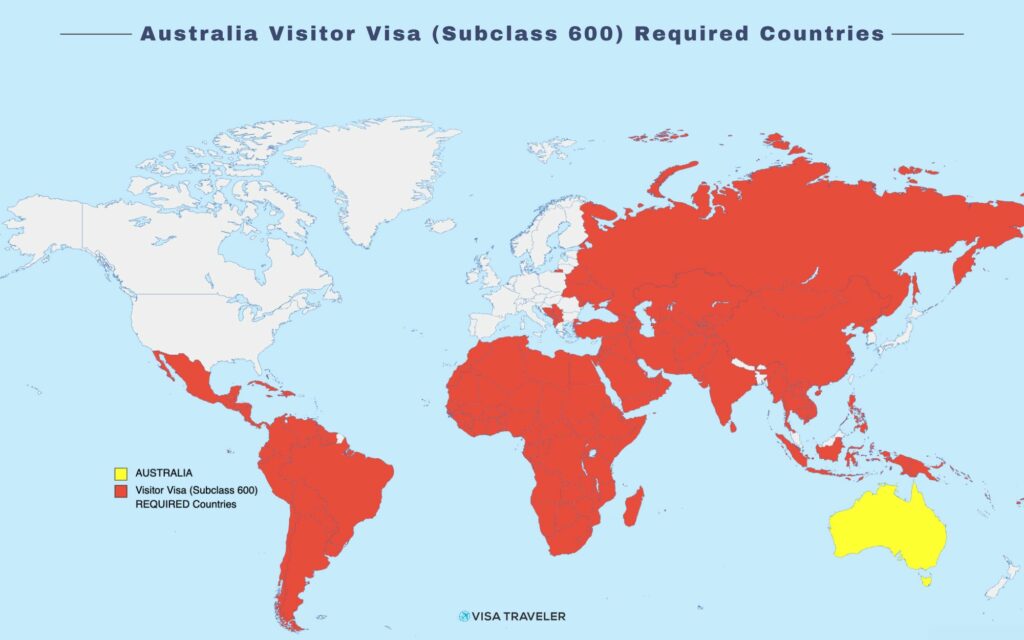
Who requires a Visitor Visa?
Australia Visitor Visa is REQUIRED for all nationalities to enter Australia as a tourist, except for the below.
- New Zealand passport holders
- Electronic Travel Authority (ETA)
- eVisitor Visa
- Those transiting in Australia for less than 72 hours and can get a Transit visa .
Documents required
To support your application, you can attach as many as 60 documents online. You don’t have to attach that many but the more documents you provide, the better your chances of approval.
You have to satisfy the Home Office that:
- You are who you say you are
- You are a genuine visitor who will not overstay or work illegally
- You are of good character and not have a criminal record
- You won’t be a burden to Australia’s healthcare system
To do this, attach as many of these documents as you can :
Identity documents
- Valid passport (must be valid for the duration of the stay)
- Valid National ID card (if from a country that issues them)
- marriage or divorce certificate;
- change of name documents;
- documents that show other names you have been known by
- Residence Permit/Visa (if residence and citizenship differ)
- One passport-size photo
Genuine visitor documents
- Itemized personal bank statements for the last 3 months. Aim to have at least 5000 AUD in your bank account. The money cannot be deposited suddenly and inexplicably – it should be from legitimate sources and savings over time.
- Tax returns
- Credit card statements
- their relationship to you
- the purpose of your visit and length of stay
- if you will be staying with them
- Proof of their funds (if they will be paying for your stay)
- Your plans or travel itinerary while in Australia
- a letter from your employer stating you plan to return to your job
- proof that you study at a school, college or university in your home country
- proof that you have immediate family members in your home country
- proof that you own a house or other major assets in your home country;
- Confirmed return flight ticket;
- Health Insurance
At a later date, you may be required to obtain and submit the following:
- Medical Certificate
- Police Clearance Certificate (PCC)
All non-English documents (except for police certificates) must be translated into English and all documents’ copies (both original and translations) must be certified.
Photo requirements
You need one passport-size digital photo for the Visitor Visa application. The photo must meet the following requirements.
- Taken in the last 6 months
- Showing your head and shoulders against a plain background
- Neutral facial expression with mouth closed, eyes open, and looking at the camera
- Religious head coverings are allowed but must not obscure the face
- Piercing is allowed but must not cause any reflections or shadows
There is no official guidance for the size and resolution of pictures uploaded online but the file type must be JPG. You will get to move the photo to position your face within a frame.
As long as the picture is clear, crisp, and not excessively big, it will be accepted.
Visitor visa fee
The Australian Tourist Visa application fee is 190 AUD , payable online.
You may also have to pay for:
- Health checks
- Police certificates
Processing time
Australian immigration reports that 50% of applications are processed in 7 days and 90% are processed in 21 days . These periods start after you submit your biometrics (if required).
Visitor Visa Application Process
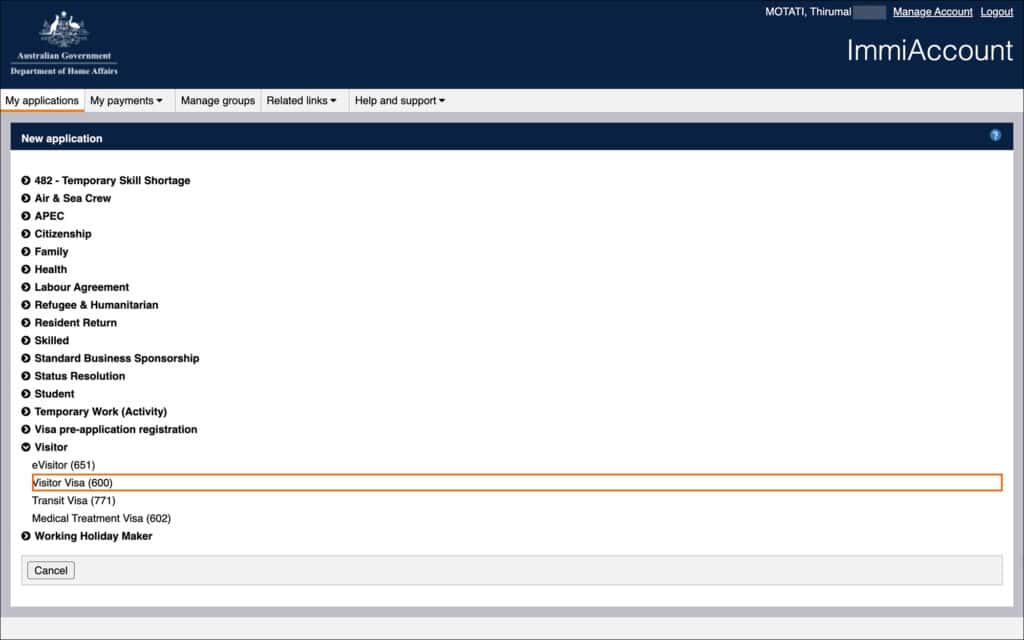
How to apply
You must apply for your tourist visa online through the Immi Portal. Applying on paper is not possible for the visitor visa anymore. Follow the below steps:
- Go to the ImmiAccount portal and create an account
- Click on “New application” and pick “Visitor Visa (600)”.
- Enter your personal information, passport details, employment details and financial information
- Upload your documents such as passport, photo, etc.
- Pay the required visa fee
- Submit the application
The Visitor Visa is part of Australia’s biometrics program. If you apply for a Visitor Visa from any of the below countries, regardless of your nationality, you must give your biometrics.
- Afghanistan
- Bosnia and Herzegovina
- Kazakhstan
- New Zealand
- Papua New Guinea
- Philippines
- Saudi Arabia
- Solomon Islands
- South Africa
- South Korea
- United Arab Emirates
If you apply from one of these countries, you will receive an email informing you that you need to visit an Australian Biometrics Collection Centre (ABCC) to have your biometrics collected. The biometrics are usually a face photo and fingerprint scan.
You must complete the biometrics procedure within 14 days of getting this email otherwise your application becomes void without a refund!
AABCs are typically managed by VFS Global. They charge a service fee for biometric collection. This fee depends on AABC and the country you are applying from.
For example, the biometric service at AABC in Dubai, UAE is AED 109.17. The biometric service fee at AABC in Manila, Philippines is PHP 557.
How to schedule biometric appointment?
Within 24 hours of applying for your Visitor Visa, you will receive an email with a biometric request letter from Home Affairs. Follow these steps to schedule your biometric appointment.
Find the nearest ABCC to you and follow the prompts to schedule your biometric appointment.
How to attend biometric appointment?
Follow the below steps to attend your biometric appointment at an AABC.
- Arrive at the AABC at least 15 minutes before your appointment time
- Original passport
- Biometric appointment confirmation
- Biometric fee receipt and
- Biometric request letter received in the email from Home Affairs
- Your facial photo is taken and your 10 fingertips are scanned
What if you can’t attend your appointment?
If you can’t make an appointment, you can reschedule your appointment up to 24 hours before your scheduled appointment date and time. You can reschedule up to 2 times.
What if you miss your appointment?
If you miss your scheduled appointment, you will lose the fee paid as the biometric fee is nonrefundable. You will also have to wait 24 hours to schedule a new appointment.
How to track status
You will receive the status of your application in your email. You can also track the status of the visa in your ImmiAccount.
How to download approved visa
When your Visitor Visa is approved, you will receive a grant letter in your email from Home Affairs. The grant letter is your Visitor Visa.
The Visitor visa is electronically linked to your passport, so you don’t need to download or print your Visitor Visa.
If you’re ever asked to show any proof, you can use the Grant Notification you received in your email. You can also download it from your ImmiAccount under “Visa Grant Details”.
How to check the validity of your Visitor Visa
The expiration date of your Australia eVisitor visa is indicated as “Must not arrive after” on the visa letter. If you lost your grant letter or don’t have a copy of your Visitor Visa, you can check the validity details on the Visa Entitlement Verification Online (VEVO) portal by using either your Visa Grant Number or Transaction Reference Number.
Customer service
Refer to the Self-help Guidelines for information to troubleshoot any issues. If facing issues with your ImmiAccount or the Visitor visa application, contact customer service using the below webform
Web: ImmiAccount Technical Support Form
Procedure at the border
The Visitor Visa is digitally attached to your passport so you don’t need to print anything. When you enter Australia, simply present your passport and be ready to answer a few basic questions about your visit.
Eligible passport holders can use the Smart Gates for faster arrival and departure procedures.
All visitors including Australian citizens are required to fill out an Incoming Passenger Card on arrival.
Frequently Asked Questions (FAQs)
How long does it take to get an australian tourist visa.
It can take up to 3 weeks to get an Australian tourist visa, especially if submitting your biometrics. It can be faster or slower depending on where you are applying from, your circumstances and the number of documents you submit.
How hard is it to get a tourist visa to Australia?
It is easy to get a tourist visa to Australia if you submit a complete application with as many documents. You must convince the Home Office that you won’t overstay or break the conditions of the visa.
How much bank balance is required for Australia tourist visa?
Australian Home Office doesn’t specify the minimum bank balance required for a tourist visa. Your bank account must show continuous cash flow and not a lump sum deposited recently.
Based on the reports from travelers reports and recommendations from embassies, you should aim for at least 5,000 AUD in your bank account when you apply.
Can you get a 3-year visitor visa to Australia?
Yes, you can get a 3-year visitor visa to Australia if are from an eligible country and meet the requirements. Australian Visitor Visa is issued for 6 months, 1 year or 3 years depending on your nationality and circumstances. For example, Indian nationals can get an Australian tourist visa valid for 3 years.
WRITTEN BY THIRUMAL MOTATI

Thirumal Motati is an expert in tourist visa matters. He has been traveling the world on tourist visas for more than a decade. With his expertise, he has obtained several tourist visas, including the most strenuous ones such as the US, UK, Canada, and Schengen, some of which were granted multiple times. He has also set foot inside US consulates on numerous occasions. Mr. Motati has uncovered the secrets to successful visa applications. His guidance has enabled countless individuals to obtain their visas and fulfill their travel dreams. His statements have been mentioned in publications like Yahoo, BBC, The Hindu, and Travel Zoo.
PLAN YOUR TRAVEL WITH VISA TRAVELER
I highly recommend using these websites to plan your trip. I use these websites myself to apply for my visas, book my flights and hotels and purchase my travel insurance.
01. Apply for your visa
Get a verifiable flight itinerary for your visa application from DummyTicket247 . DummyTicket247 is a flight search engine to search and book flight itineraries for visas instantly. These flight itineraries are guaranteed to be valid for 2 weeks and work for all visa applications.
02. Book your fight
Find the cheapest flight tickets using Skyscanner . Skyscanner includes all budget airlines and you are guaranteed to find the cheapest flight to your destination.
03. Book your hotel
Book your hotel from Booking.com . Booking.com has pretty much every hotel, hostel and guesthouse from every destination.
04. Get your onward ticket
If traveling on a one-way ticket, use BestOnwardTicket to get proof of onward ticket for just $12, valid for 48 hours.
05. Purchase your insurance
Purchase travel medical insurance for your trip from SafetyWing . Insurance from SafetyWing covers COVID-19 and also comes with a visa letter which you can use for your visas.
Need more? Check out my travel resources page for the best websites to plan your trip.
LEGAL DISCLAIMER We are not affiliated with immigration, embassies or governments of any country. The content in this article is for educational and general informational purposes only, and shall not be understood or construed as, visa, immigration or legal advice. Your use of information provided in this article is solely at your own risk and you expressly agree not to rely upon any information contained in this article as a substitute for professional visa or immigration advice. Under no circumstance shall be held liable or responsible for any errors or omissions in this article or for any damage you may suffer in respect to any actions taken or not taken based on any or all of the information in this article. Please refer to our full disclaimer for further information.
AFFILIATE DISCLOSURE This post may contain affiliate links, which means we may receive a commission, at no extra cost to you, if you make a purchase through a link. Please refer to our full disclosure for further information.
MORE VISA GUIDES

UNITED KINGDOM

VIEW ALL VISA GUIDES
- Cookie Policy
- Copyright Notice
- Privacy Policy
- Terms of Use
- Flight Itinerary
- Hotel Reservation
- Travel Insurance
- Onward Ticket
- Testimonials
Search this site
Visa requirements for visiting Australia

Dec 1, 2023 • 6 min read

Don't let a forgotten tourist visa ruin your Australian getaway © xavierarnau/Getty Images
Planning a trip to Australia ? Whether you’re heading Down Under for a short break or extended working holiday, you’ll likely need a visa.
Here’s your complete guide to filling out your paperwork for a visit to Australia.
Do I need a visa for Australia?
Most visitors to Australia will need a visa, but the type of visa you apply for depends on your country of origin, how long you plan to stay in Australia and what you plan to do while you’re there.
Most tourists must apply for either an Electronic Travel Authority (ETA) or a visitor visa before traveling. The exception is New Zealand passport holders, who are issued a Special Category visa upon arrival.
Your passport must be valid for the duration of your intended stay. You’ll also need to ensure you have sufficient funds to cover your stay. Depending on your visa category, you may be asked for proof of this upon arrival.
What type of visa do I need to travel to Australia?
The Australian Department of Home Affairs’ (DoHA) visa finder can help you determine what visas you’re eligible for based on your citizenship, your travel purpose and your intended length of stay.
Here are the three main tourist visa categories:
For visitors from visa-exempt countries: ETA (subclass 601)
If you hold a passport from a visa-exempt country – including the United States, the United Kingdom, Canada or Singapore – you’re eligible for an Electronic Travel Authority (ETA) . With an ETA you can visit Australia as many times as you like for tourism purposes within a one-year window, staying for up to three months per visit.
Attached digitally to your passport number, an ETA allows for a simplified entry process into Australia. An application needs to be completed via the dedicated ETA app before you arrive and usually is processed within a day. However, it’s recommended that you apply for it a few days in advance to ensure you have the ETA in time for your departure.
While ETAs are free, there is an application service charge of $20.
If you’re already in Australia and you want to extend your stay, you will need to apply for a Visitor visa.
For visitors from European countries: eVisitor visa (subclass 651)
The eVisitor visa is free and available for passport holders from most European countries. It offers similar conditions to an ETA: Visitors can stay for up to three months for tourism purposes. It’s valid for 12 months, with multiple entries permitted.
You can apply for the eVisitor online. Processing time is usually within a day, but it’s recommended that you apply well in advance of your intended travel date in case of delays. This visa can’t be extended, so if you wish to stay longer, you’ll need to apply for a Visitor visa.
If you hold a passport from a country that’s eligible for both an ETA and an eVisitor visa, you’ll find the two options are nearly identical. The main difference is how you apply for them: ETAs must be applied for through an app with a fee of $20. There is no charge for eVisitor visas, but you’ll need to register for an ImmiAccount and apply online through a web browser.
For all other tourists: Visitor visa (subclass 600)
If you’re not eligible for an ETA or an eVisa and plan to visit Australia for tourism-related purposes, you’ll need to apply for a Visitor visa from outside Australia. This visa may be granted for up to 12 months and may be single or multiple entry. Conditions are determined on a case-by-case basis. A visitor visa starts at $190, but there may be other associated costs including health examinations, police clearances or biometrics, depending on your passport.
Although most visitor visas are processed within a few weeks, it can take longer in peak periods, so it must be applied for well in advance of your trip. Standard processing times change regularly and can be monitored on the DoHA site.
Once you apply, you can track your application through your ImmiAccount. You may be required to submit additional information, so check your application regularly to provide any further details to keep the process moving.
How do I extend my visa to Australia?
Enjoying your stay in Australia and don't want to leave? We don’t blame you.
Depending on your visa, you may be able to apply for a new visa to stay in the country longer. Visitors who are already inside Australia and wish to stay longer as tourists may use the onshore Visitor visa (also subclass 600) to extend their stay.
Make sure you apply for your new visa before your current visa expires. If you’ve submitted your application before your current visa expires, you’ll be granted a free bridging visa until your new one is processed.
What if I want to work and travel around Australia?
Working holidays are a popular option for travelers who want to fund their adventures and immerse themselves in Australian life and culture.
Australia’s Working Holiday Maker program is available for visitors between the ages of 18 and 30 (and up to 35 in some cases) from 40 participating countries and jurisdictions around the world.
There are two classes of visas available under this program: t he Working Holiday visa (subclass 417) and the Work and Holiday visa (subclass 462) . Which one you apply for depends on the passport you hold. Both are valid for 12 months and cost $635, and both enable you to legally work while in Australia.
Many working holiday visa makers find that one year isn’t enough. Fortunately, you may be able to extend your working holiday visa for a second or even a third year. In order to do so, you’ll need to complete “specified work” in a “regional area” for a period of three months (for a second year) or six months (for a third year) first.
This specified work is usually referred to as “farm work” in backpacker circles, but it’s a bit of a misnomer. It’s a common misconception that you need to head to the woop-woops (that Aussie for “middle of nowhere”) and pick fruit to complete your specified work. In fact, there are a range of approved industries the program , including tourism and hospitality, construction and bushfire recovery. Likewise, “regional areas” aren’t just found in remote rural areas; some major cities (including Darwin and Adelaide) are eligible post codes. So while you might find yourself harvesting bananas in a tiny town in tropical Queensland, you could just as easily find yourself serving tables at a luxury lodge in Darwin or working in a winery in the Barossa.
For more information on the working holiday visa program, you can also visit Tourism Australia’s dedicated portal.
This article was first published March 2021 and updated December 2023
Explore related stories

Art and Culture
Apr 4, 2024 • 5 min read
Perth’s immersive Indigenous experiences, stunning scenery and innovative culinary scene make it one of Australia's most exciting cities.

Mar 30, 2024 • 4 min read

Mar 4, 2024 • 8 min read

Feb 27, 2024 • 6 min read

Feb 12, 2024 • 10 min read

Jan 30, 2024 • 9 min read

Jan 29, 2024 • 11 min read

Jan 17, 2024 • 8 min read

Jan 7, 2024 • 3 min read

Jan 5, 2024 • 20 min read

CONTACT US --> 1800 808 717 INSTANT Consultation, call Now!
Processing times, processing times: visitor visas subclass 600, 601 & 651.
If you would like to come to Australia for a holiday, you will need to apply for a visitor visa. There are three types of visitor visas and your country of origin will determine which visa you can apply for, including:
- Visitor visa (subclass 600);
- Electronic Travel Authority visa (subclass 601); and
- eVisitor (Subclass 651)
601 & 651 Visa Processing Times
600 visa processing times, visitor visa (600, 601 & 651) timeline & stages.
Results Migration can help you get your visitor visa and will take you through the following stages:
- Schedule a free consultation with Results Migration to decide which visitor visa option is best for your circumstances
- Results Migration will help you lodge your application
- Results Migration can also assist you in organising your travel insurance and declaring any criminal convictions that may affect your application
Common issues that cause delays in visitor visa processing times
There are many reasons why your application may be delayed, including:
- Whether you have lodged a complete application, including all necessary supporting documents;
- How quickly you respond to any requests for additional information;
- How long it takes to perform required checks on the supporting information provided; and
- How long it takes to receive additional information from external agencies, particularly in relation to health and character requirements
How can Results Migration help you?
Results Migration have an abundance of experience with visitor visas and will be able to assist you from beginning until end. Results Migration will also provide the information to your employer so make sure that your application moves as quickly as possible.
For more information visit:
https://www.homeaffairs.gov.au/trav/visa-1/600-
https://www.homeaffairs.gov.au/trav/visa-1/601-
https://www.homeaffairs.gov.au/trav/visa-1/651-#tab-content-1
Your Name (required)
Your Phone Number (required)
Visa Type Enquiry (required) Skilled Visa Employer Sponsored Visas Business Visas Student Visas Family Visas Travel Visas Visa Appeals
How do I find the right visa to travel to Australia?
Explore visas on the Department of Home Affairs website for Australian visa options that might suit your needs.
Can I apply for an Electronic Travel Authority (ETA) subclass 601?
There are specified passports that are eligible to apply for an ETA . Individuals who hold a non-citizen passport, certificate of identity or other travel document cannot apply for an ETA.
I tried to apply for an ETA and received a message saying that the application cannot be assessed. What do I do now?
This means that the application is one of a small number of applications that cannot be approved over the internet due to checks required by the Australian Government. Do not submit the application again. If you do, the result will be the same and your credit card will be charged again.
If you have had any criminal convictions in any country, you should obtain police checks and other relevant character documents then apply for a Visitor visa (subclass 600) , rather than an ETA to be assessed against the character requirements . If you arrive on an ETA with criminal convictions, you could be refused entry to Australia. Additionally, if you do not meet the health requirements you should apply for a Visitor visa (subclass 600) , rather than an ETA. To start an online application you will need to create an ImmiAccount or login to your existing account.
If you do not have any health or character concerns and were unsuccessful in obtaining an ETA online (including passport holders from Taiwan) please contact the Global Service Centre at +61 2 6196 0196 to progress your application. You will need to provide your ETA reference number and passport details.
How long will my application take to process?
Global visa processing times for all visa and citizenship applications are posted on the Department of Home Affairs website and updated monthly, providing an indicative timeframe for processing applications. Processing times are impacted each month by changes in application volumes, seasonal peaks, complex cases, and incomplete applications.
How can I check the status of my application or visa?
Log into your ImmiAccount to check the progress of an online application. You can also import a paper application into ImmiAccount to view the progress.
Visa Entitlement Verification Online (VEVO) is a free online service that gives visa holders, employers and other registered organisations access to visa entitlements and status information 24 hours a day.
Can I get my visa application expedited?
The department does not offer an expedited service. All visa applications are assessed based on their individual merits and against set legal requirements. It is important that you submit a complete application to avoid any delays with the application.
We strongly recommend that you should not book flights or make travel commitments until you have a visa to travel to Australia. The department will not be liable for any financial loss incurred by applicants whose visa application was finalised later than expected or where an application is unsuccessful. If applicants travel to the airport without a visa to enter Australia they do so at their own risk and expense.
Please note that the embassy is unable to answer visa and citizenship enquiries.
What travel is allowed on an APEC Business Travel Card (ABTC) visa?
A Visitor (Business) subclass 600 visa granted in relation to an ABTC allows travel for short-stay business purposes as well as short non-business travel, such as to have a holiday or visit family and friends. Please see the Department of Home Affairs website for further information on ABTC travel
I would like to work in Australia, what do I need to do?
Explore work visas options on the Department of Home Affairs website.
What if I want to study in Australia?
Explore student visa options on the Department of Home Affairs website.

What if I want to migrate to Australia?
Explore visa options on the Department of Home Affairs website for options to become a permanent resident or join a partner or family in Australia.
I have an occupation or skill that may be needed in Australia, how do I find out what is accepted?
Information on skilled work in Australia, including the skilled occupation list, can be found on the Department of Home Affairs website .
I am a returning resident, what are my visa options?
There are visa options available for current or former Australian permanent residents, or former Australian citizens to re-enter Australia.
What character requirements am I required to meet to enter Australia?
Everyone who wishes to enter Australia must be assessed against the character requirements .
What health requirements am I required to meet to enter Australia?
Everyone who wishes to enter Australia must meet the health requirement .
Are there migration agents who can assist with my application?
Information on finding and using a registered migration agent can be found on the Department of Home Affairs website.
What travel document do I need to enter Australia?
Everyone entering Australia must present a valid and approved travel document as evidence of their identity and nationality. Australian visas are electronically attached to the valid passport used on the visa application.
Do Australian citizens have to enter Australia on an Australian passport?
Australian citizens should hold an Australian passport to enter and leave Australia, even when using a foreign passport overseas. The Australian Passport Office provides information on how to apply for an Australian passport .
Can I travel on a passport with a different name to my airline ticket?
You should contact your airline to see if they will carry you. If so, you should then contact the immigration department of all countries to which you are travelling (except Australia) to ensure you will be able to fulfil their immigration/customs requirements.
How can I update my passport details with the Department?
You can update your details online through your ImmiAccount.
How can I request my international movement records?
If you require international movement records for Australia please complete Form 1359 Request for international movement records and email to the address provided on the form.
If you require records prior to 1981 please contact the National Archives of Australia www.naa.gov.au
Information on Australian visas and citizenship , as well as ways to contact us , can be found on the Department of Home Affairs website .
Please note that the Embassy and Consulates are unable to answer visa and citizenship enquiries.
Create profile
Like courses
Apply direct
Create your IDP profile
To continue your research, create your profile with IDP. Your profile allows you to:
- Apply direct to courses and receive a response within the same day
- Shortlist and save courses
- Get the AI course recomendations
- Access our cost of living calculator
Match with universities
Now create a profile
Create a profile and start liking courses. We’ll show you recommendations that match what you’re looking for.
Your password must include
- One upper case letter
- One lower case letter
- One special character
- At least 8 characters
- IDP Australia
- Study to migrate
- Visitor Visa 600 - Cost, Processing time, checklist

- English Chinese

Visa 600 - A guide to studying on the Australian visitor visa 600
- The Subclass 600 visa allows for various purposes such as tourism, business visits, visiting family, and short educational courses under three months.
- Choose from visa durations of three, six, or twelve months with straightforward conditions.
- It can serve as a short-term extension if your current visa, like a student visa, is expiring.
- For visa application inquiries, contact us today!
If you are still looking for further details around the subclass 600 visa, read on below.
The step by step process to apply for visa 600
Whether you are in Australia or located in another country, the process is the same.
- Go to the official Australian ImmiAccount page and set up a log in.
- Fill out all the required information and provide all the documents asked for.
- Submit the application and pay the required fees. If you do not provide all the information required, your visa may be denied or the processing time may be greatly increased.
- You may be asked to supply biometrics at a local processing centre in your home country.
Visa 600 fees
You can check the fees here.
Visa processing time
This visa has one of the fastest turnaround times. Talk to one of our expert agents today to find out how quickly this can be processed depending on your personal circumstances.
Eligibility criteria and visa conditions
The list of criteria are short, compared to other visa types. You must:
- intend to complete a period of study no longer than three months long
- have adequate health insurance
- have enough money to support your stay
Documents required for visa 600
The Australian immigration authority can request different documents according to the country of origin and the intention of the visitor once in Australia. You may be required to supply:
- a completed application form
- copies of biographical page of passport
- a recent passport-sized photograph with your name written on the back
- details of any name changes
- copy of birth certificate
- proof of sufficient funds for your stay in Australia, such as a bank statement
- proof there is incentive to return to your home country, such as enrolment at school, employment proof, or proof of ownership of assets in your home country
- evidence of enrolment at the learning institution
- evidence of a return flight ticket
How can people transfer from visitor visa 600 to student visa?
Transferring from a visitor visa to a student visa while you are in Australia can be complex pathway. It can only be done if your visitor visa doesn’t have any ‘no further stay’ conditions. Moving from a visitor visa to student visa also increases your chances of your visa application being refused, due to the genuine temporary entrant (GTE) requirement. The immigration department may claim that the reasons for your education visa are not genuine, and this could be a reason they may decline your student visa application.
For either of these scenarios, you will need to return to your home country and apply for a student visa from there.
If you have condition 8503 applied to your tourist visa conditions, you can apply to have this waived. This condition states that the visa holder will not be entitled to a substantive visa while they remain in Australia. You must satisfy the department that your circumstances have changed, the circumstances were beyond your control, and be compelling.
Alongside the usual student visa requirements, you will be required to prove to the Australian immigration department:
- that your reasons for not studying in your home country are valid
- that you have sufficient reasons to return to your home country once your student visa has expired
- there is no unrest in your home country that could stop you from returning home freely
- there is nothing in your immigration history that indicates your intention to remain in Australia
- the course is valid, relevant, and appropriate to your current education or employment
- that this course will ensure future employment
- that you have complied with all previous and current visa terms, and have the continued intention to comply with the new student visa.
You will be required to prepare a written statement demonstrating your GTE, addressing all the factors above. Evidence of your claims should also be included.
Find out if visa 600 is the best option for you
Find out how IDP Education can help you with your visa requirements to study and migrate in Australia. Contact us to help with course selection, visa assistance and guidance on navigating your education goals.
Our History
We’ve been connecting people like you with education in Australia since 1969. It’s this history in Australian education that translates into the best outcome for you.
Study in Australia
Australia offers a diverse range of study options for international students, with more than 1,100 institutions and 22,000 courses to choose from.
- Search for courses
- Find a university
- Find a scholarship
Please select a level of study
Enter subject, choose from the list or hit search
Start typing, choose from the list or hit search
Enter subject, choose from the list or or hit search
Please type and select an institution
Type 1 character of a university name and select from the list
Enter a university or school name and select from the list
Got any ideal countries in mind?
No Event Found.
Let’s get started
Sign up or login in with one click, sign up or login to save your courses, let's get started with "shortlist".
Your profile page will have the liked courses.
has been saved to your shortlist
View your shortlist or close this box to continue researching.
- Courses for you

Countries, economies and regions
Select a country, economy or region to find embassies, country briefs, economic fact sheets, trade agreements, aid programs, information on sanctions and more.
International relations
Global security.
- Australia and sanctions
- Australian Safeguards and Non-proliferation Office (ASNO)
- Counter-terrorism
- Non-proliferation, disarmament and arms control
- Peacekeeping and peacebuilding
Regional architecture
- Asia Pacific Economic Cooperation (APEC)
- Association of Southeast Asian Nations (ASEAN)
- East Asia Summit (EAS)
- Australia and the Indian Ocean region
- Pacific Islands regional organisations
Global themes
- Child protection
- Climate change
- Cyber affairs and critical technology
- Disability Equity and Rights
- Gender equality
- Human rights
- Indigenous peoples
- People Smuggling, Human Trafficking and Modern Slavery
- Preventing Sexual Exploitation, Abuse and Harassment
- Australia’s treaty-making process
International organisations
- The Commonwealth of Nations
- United Nations (UN)
- World Trade Organization
Foreign Arrangements Scheme
Trade and investment, about free trade agreements (ftas).
- The benefits of FTAs
- How to get free trade agreement tariff cuts
- Look up FTA tariffs and services market access - DFAT FTA Portal
- Discussion paper on potential modernisation – DFAT FTA Portal
About foreign investment
- The benefits of foreign investment
- Investor-state dispute settlement (ISDS)
- Australia's bilateral investment treaties
- Australia's foreign investment policy
For Australian business
- Addressing non-tariff trade barriers
Expo 2025 Osaka, Kansai
Stakeholder engagement.
- Ministerial Council on Trade and Investment
- Trade 2040 Taskforce
- First Nations trade
Australia's free trade agreements (FTAs)
- ASEAN-Australia-New Zealand (AANZFTA)
- Chile (ACLFTA)
- China (ChAFTA)
- Hong Kong ( A-HKFTA & IA)
- India (AI-ECTA)
- Indonesia (IA-CEPA)
- Japan (JAEPA)
- Korea (KAFTA)
- Malaysia (MAFTA)
- New Zealand (ANZCERTA)
- Peru (PAFTA)
- Singapore (SAFTA)
- Thailand (TAFTA)
- United Kingdom (A-UKFTA)
- USA (AUSFTA)
- Trans-Pacific Partnership (TPP)
- European Union (A-EUFTA)
- India (AI-CECA)
- Australia-UAE Comprehensive Economic Partnership Agreement
- Australia-Gulf Cooperation Council (GCC)
Trade and investment data, information and publications
- Fact sheets for countries and regions
- Australia's trade balance
- Trade statistics
- Foreign investment statistics
- Trade and investment publications
- Australia's Trade through Time
WTO, G20, OECD, APEC and IPEF and ITAG
Services and digital trade.
- Service trade policy
- Australia-Singapore Digital Economy Agreement
- Digital trade & the digital economy
Development
Australia’s development program, performance assessment.
- Development evaluation
- Budget and statistical information
Who we work with
- Multilateral organisations
- Non-government organisations (NGOs)
- List of Australian accredited non-government organisations (NGOs)
Development topics
- Development issues
- Development sectors
2030 Agenda for Sustainable Development
- Sustainable Development Goals
Where we deliver our Development Program
Humanitarian action.
Where and how Australia provides emergency assistance.
People-to-people
Australia awards.
- Australia Awards Scholarships
- Australia Awards Fellowships
New Colombo Plan
- Scholarship program
- Mobility program
Public diplomacy
- Australian Cultural Diplomacy Grants Program
- Australia now
- UK/Australia Season 2021-22
Foundations, councils and institutes
- Australia-ASEAN Council
- Australia-India Council
- Australia-Indonesia Institute
- Australia-Japan Foundation
- Australia-Korea Foundation
- Council for Australian-Arab Relations (CAAR)
- Council on Australia Latin America Relations (COALAR)
International Labour Mobility
- Pacific Labour Mobility Scheme
- Agriculture Visa
Australian Volunteers Program
Supporting organisations in developing countries by matching them with skilled Australians.
Sports diplomacy
Australia is a successful global leader and innovator in sport.
A global platform for achievement, innovation, collaboration, and cooperation
- About Australia
Australia is a stable, democratic and culturally diverse nation with a highly skilled workforce and one of the strongest performing economies in the world.
Australia in Brief publication
This is the 52nd edition of Australia in Brief, revised and updated in February 2021
Travel advice
To help Australians avoid difficulties overseas, we maintain travel advisories for more than 170 destinations.
- Smartraveller – travel advice
International COVID-19 Vaccination Certificate
Prove your COVID-19 vaccinations when you travel overseas.
- Services Australia
The Australian Passport Office and its agents are committed to providing a secure, efficient and responsive passport service for Australia.
- Australian Passport Office
24-hour consular emergency helpline
- Within Australia: 1300 555 135
- Outside Australia: +61 2 6261 3305
- Getting help overseas
- Visas for Australians travelling overseas
Visas to visit Australia
Whether you are visiting Australia for less than 72 hours or planning on a stay of several years you must have a valid Australian visa.
A visa is a form of permission for a non-citizen to enter, transit or remain in a particular country.
Information on visas to Australia can be found at the Department of Home Affairs .
Related links
- Visiting Australia
- Australia.com - official Australian tourism website
Winter is here! Check out the winter wonderlands at these 5 amazing winter destinations in Montana
- Travel Destinations
- Australia & South Pacific
How Long Can You Stay In Australia With A Tourist Visa?
Published: November 7, 2023
Modified: December 28, 2023
by Isobel Payton
- Plan Your Trip
Introduction
Planning a trip to Australia? One of the first things you need to consider is your visa. Australia offers various types of tourist visas to visitors from around the world, allowing them to explore the breathtaking landscapes, vibrant cities, and unique cultural experiences that the country has to offer.
Understanding the duration of stay allowed on a tourist visa is crucial for proper trip planning. It determines how long you can legally remain in Australia, explore its attractions, and indulge in its diverse offerings.
In this article, we will provide an overview of Australia’s tourist visa options and explain the duration of stay permitted for each type. We will also discuss the factors that can impact the length of your stay and the potential consequences of overstaying your visa.
Whether you are applying for an Electronic Travel Authority (ETA) subclass 601, an eVisitor subclass 651, or a Visitor visa subclass 600, this article will help you have a clear understanding of the time you can spend in Australia as a tourist.
Overview of Australia’s tourist visa
Australia offers several types of tourist visas to cater to the needs of different travelers. These visas allow individuals to visit the country for tourism or recreational purposes, such as vacationing, sightseeing, or visiting family and friends.
There are three main types of tourist visas available:
- Electronic Travel Authority (ETA) subclass 601: This is the most common type of tourist visa for visitors from eligible countries. It is electronically linked to the passport and allows multiple stays of up to three months each within a 12-month period.
- eVisitor subclass 651: This visa is specifically designed for citizens of European Union (EU) member countries and a few other European countries. It enables multiple short-term visits to Australia for tourism or business purposes, with each visit being up to three months within a 12-month period.
- Visitor visa subclass 600: This visa caters to visitors who are not eligible for an ETA or eVisitor visa. It allows individuals to visit Australia for tourism, visiting family or friends, or other short-term non-work purposes. The duration of stay can vary depending on the individual circumstances and visa conditions.
It’s important to determine the most suitable visa type for your specific travel needs. Each visa has its own requirements, application process, and permitted duration of stay. Understanding the characteristics of each visa will help you make an informed decision and ensure a successful visit to Australia.
In the next sections, we will delve deeper into the duration of stay permitted for each type of tourist visa, as well as the factors that can influence the length of your stay.
Duration of stay for different types of tourist visas
The duration of stay permitted on a tourist visa in Australia varies depending on the type of visa you hold. Let’s take a closer look at the duration of stay for each of the three main tourist visa types:
- Electronic Travel Authority (ETA) subclass 601: With an ETA visa, you can stay in Australia for a maximum of three months per visit. This visa allows multiple entries within a 12-month period from the date of grant or until the passport expires, whichever comes first. However, each stay must not exceed three months.
- eVisitor subclass 651: The eVisitor visa grants visitors a maximum stay of three months per visit as well. Like the ETA visa, it allows multiple entries within a 12-month period from the date of grant or until the passport expires. Similar to the ETA visa, each stay must not exceed three months.
- Visitor visa subclass 600: The duration of stay for a Visitor visa subclass 600 can vary depending on the visa conditions and individual circumstances. The visa may allow stays ranging from three months to 12 months, depending on the purpose of the visit and the conditions specified by the Department of Home Affairs. It is important to check the specific conditions and validity period of your Visitor visa subclass 600 to determine your allowed stay duration.
It’s worth mentioning that the duration of stay is typically calculated from the date of your arrival in Australia. It is essential to comply with the visa conditions and ensure that you depart the country before the authorized period ends.
Now that we have covered the basic duration of stay for each visa type, let’s explore the factors that can affect the length of your stay in Australia on a tourist visa.
Electronic Travel Authority (ETA) subclass 601
The Electronic Travel Authority (ETA) subclass 601 is a popular tourist visa option for visitors from eligible countries. This visa allows for multiple short-term visits to Australia for tourism or business purposes.
With an ETA visa, you are permitted to stay in Australia for a maximum of three months per visit. However, it’s important to note that each stay must not exceed three months, and the total duration of your visits should not exceed three months within a 12-month period.
The ETA visa is electronically linked to your passport, eliminating the need for a physical visa label. This makes it a convenient and efficient option for eligible travelers. The ETA visa can be applied for online, either directly through the Australian government’s website or through a travel agent or airline.
It’s important to mention that the ETA visa allows for multiple entries within the 12-month period from the date of grant or until the passport expires, whichever comes first. This means that you can leave and re-enter Australia multiple times during the validity of your visa.
It’s crucial to comply with the visa conditions and ensure that you depart Australia before the authorized period ends. Overstaying your visa can have serious consequences, including future visa rejections, penalties, and even a re-entry ban. Therefore, it is essential to plan your trip and keep track of your stay duration to avoid any complications.
It’s also worth noting that the validity period of an ETA visa is commonly determined by the passport’s expiration date. If your passport expires before the 12-month period is over, your ETA visa will cease to be valid, and you will need to apply for a new visa with your new passport.
The ETA visa offers flexibility and ease of use for eligible visitors, making it a popular choice for those planning a short-term visit to Australia for tourism or business purposes.
Next, let’s explore the second type of tourist visa available for Australia: the eVisitor subclass 651.
eVisitor subclass 651
The eVisitor subclass 651 visa is specifically designed for citizens of European Union (EU) member countries, as well as a few other European countries. This visa allows for multiple short-term visits to Australia for various purposes, including tourism or business.
Similar to the ETA visa, the eVisitor visa grants visitors a maximum stay of three months per visit. Each stay must not exceed three months, and the total duration of your visits should not exceed three months within a 12-month period.
The eVisitor visa, like the ETA visa, is electronically linked to your passport, making it efficient and convenient to use. It allows for multiple entries within the 12-month period from the date of grant or until the passport expires, whichever comes first.
To apply for an eVisitor subclass 651 visa, you can use the Australian government’s online application system or enlist the services of a travel agent or airline. The application process is straightforward, and you will need to provide the necessary documentation and meet the eligibility criteria.
It’s important to note that the eVisitor visa does not grant you the right to work in Australia. If you plan to work during your visit, you will need to explore alternative visa options that allow for work authorization.
As with any visa, it is essential to comply with the conditions and validity period of the eVisitor visa. Ensure that you depart Australia before the authorized period ends to avoid any penalties or future visa complications.
It’s also crucial to keep in mind that the eVisitor visa is not available to all countries. Only citizens of EU member countries and a select few European countries are eligible for this visa. If you are not from one of these countries, you will need to consider other visa options, such as the Visitor visa subclass 600.
Now that we’ve covered the eVisitor subclass 651 visa, let’s move on to discussing the Visitor visa subclass 600, which is suitable for visitors who are not eligible for an ETA or eVisitor visa.
Visitor visa subclass 600
The Visitor visa subclass 600 is a versatile visa option for visitors who are not eligible for an Electronic Travel Authority (ETA) or eVisitor visa. It allows individuals to visit Australia for tourism, visiting family or friends, or other short-term non-work purposes.
The duration of stay for a Visitor visa subclass 600 can vary depending on the visa conditions and individual circumstances. Generally, the visa may allow stays ranging from three months to 12 months, providing greater flexibility for travelers with longer-term plans in Australia.
It’s crucial to carefully review the specific conditions and validity period of your Visitor visa subclass 600 to determine your allowed stay duration. These conditions are typically outlined in the visa grant notice or in the visa label affixed to your passport.
When applying for a Visitor visa subclass 600, you will need to demonstrate your intention to visit Australia temporarily and satisfy the visa requirements as specified by the Department of Home Affairs. The application process involves submitting the necessary documentation and paying the applicable visa fees.
Unlike the ETA and eVisitor visas, the Visitor visa subclass 600 may have additional requirements, such as health examinations or character assessments, depending on the individual circumstances and proposed activities in Australia.
It’s important to note that the Visitor visa subclass 600 does not provide work authorization. If you plan to work during your visit, you will need to explore alternative visa options that allow for employment in Australia.
As with any tourist visa, it is imperative to comply with the conditions and validity period of the Visitor visa subclass 600. Overstaying your visa can have serious consequences, including future visa rejections, penalties, and even a re-entry ban. Ensure that you depart Australia before the authorized period ends to avoid any complications.
Now that we’ve explored the three main types of tourist visas available for Australia, it’s important to understand the factors that can affect the duration of your stay on a tourist visa.
Factors affecting the duration of stay
Several factors can influence the duration of stay permitted on a tourist visa in Australia. While the specific conditions vary depending on the type of visa you hold, here are the key factors to consider:
- Visa conditions and validity period: Each tourist visa has its own set of conditions and validity period that determine how long you can stay in Australia. It is essential to review the visa grant notice or label to understand the specific conditions and duration applicable to your visa type.
- Extension and multiple entries: Some visas, such as the Electronic Travel Authority (ETA) subclass 601 and the eVisitor subclass 651, allow for multiple entries within a specified timeframe. This gives you the flexibility to leave and re-enter Australia multiple times as long as it is within the authorized period.
- Individual circumstances and immigration assessment: Your individual circumstances and the assessment made by the Department of Home Affairs can affect the duration of your stay. If you have compelling reasons or exceptional circumstances, you may be granted a longer stay period. Conversely, if there are concerns regarding your intentions or compliance, a shorter stay duration may be imposed.
It’s important to note that the duration of stay allowed on a tourist visa is typically calculated from the date of your arrival in Australia. It is crucial to monitor your stay and ensure that you leave the country before the authorized period ends to avoid any visa violations.
As each visa type has different conditions and considerations, it is advisable to consult the official Australian government website or seek professional advice to better understand the factors that may affect the duration of your stay on a specific visa.
Now that we have explored the factors influencing the duration of stay, it’s crucial to understand the potential consequences of overstaying your visa.
Visa conditions and validity period
One of the key factors that can affect the duration of your stay in Australia on a tourist visa is the set of conditions and validity period specified by the visa. These conditions are outlined in the visa grant notice or in the visa label affixed to your passport.
Each type of tourist visa has its own specific conditions and validity period that determine how long you can legally stay in Australia. It is crucial to thoroughly review and understand these conditions to ensure compliance and avoid any legal issues.
The conditions and validity period of a tourist visa can vary depending on factors such as the visa subclass, the purpose of your visit, and your individual circumstances. For example, an Electronic Travel Authority (ETA) subclass 601 visa typically allows for multiple short-term visits of up to three months each within a 12-month period. On the other hand, a Visitor visa subclass 600 may have a duration of stay ranging from three months to 12 months, depending on the specific conditions assigned to the visa.
In addition to the duration of stay, visa conditions may include restrictions or limitations on activities such as employment, studying, or healthcare access. It’s important to understand and abide by these conditions during your stay in Australia.
Visa validity refers to the period during which the visa is considered legally active and can be used for travel and entry into Australia. It’s essential to take note of the visa’s validity period as this can impact the timing and length of your visit. If your visa expires while you are in Australia, it can lead to complications and potential visa violations.
Remember that the visa validity period is often determined by the expiration date of your passport. If your passport expires before the visa’s validity period ends, your visa will cease to be valid, and you will need to obtain a new visa with your new passport.
It is crucial to comply with the conditions and validity period of your tourist visa. Failure to do so can result in penalties, future visa rejections, and even a re-entry ban. Therefore, it is recommended to carefully plan your visit and ensure you leave Australia before your visa expires.
Now that we have discussed the importance of visa conditions and validity period, let’s move on to the next factor that can affect the duration of your stay in Australia on a tourist visa.
Extension and multiple entries
Another factor that can impact the duration of your stay in Australia on a tourist visa is the ability to extend your stay and the provision for multiple entries.
Depending on the type of visa you hold, there may be opportunities to extend your stay beyond the initial duration granted. Extensions are typically granted on a case-by-case basis and are subject to various factors, including the purpose of your visit, your activities in Australia, and the discretion of the Department of Home Affairs.
If you wish to extend your stay, it is important to apply for an extension before your current visa expires. Failing to do so may result in your visa expiring and potential issues with your immigration status. Extension applications should be made through the appropriate channels, such as online application systems or by reaching out to the Department of Home Affairs.
In addition, certain types of visas, such as the Electronic Travel Authority (ETA) subclass 601 or the eVisitor subclass 651, allow for multiple entries within a specified timeframe. This means that you can leave and re-enter Australia multiple times during the validity of your visa. Each entry is treated as a separate visit, with the duration of stay resetting upon each entry.
For example, if you hold an ETA visa, you can enter Australia multiple times within the 12-month period from the date of grant or until the passport expires. However, each stay must not exceed three months. This provision for multiple entries can be beneficial if you plan to explore other countries in the region and return to Australia during your trip.
It is important to note that the ability to extend your stay or seek multiple entries may vary depending on the visa type and specific circumstances. It is always recommended to check the conditions and limitations associated with your specific visa subclass to understand your options for extension and re-entry.
Remember that extending your stay or seeking multiple entries is not guaranteed. The decision is ultimately at the discretion of the Department of Home Affairs and is subject to their assessment of your circumstances and compliance with visa regulations.
By being aware of the extension and multiple entry provisions of your tourist visa, you can plan your stay in Australia more effectively and make the most of your time in the country.
Next, we will explore the third factor that can affect the duration of your stay in Australia on a tourist visa: individual circumstances and immigration assessment.
Individual circumstances and immigration assessment
When it comes to determining the duration of stay on a tourist visa in Australia, individual circumstances and immigration assessment play an important role. These factors take into account the specific details and considerations of each visitor’s situation.
The Department of Home Affairs carefully assesses individual circumstances and intentions to ensure compliance with visa regulations. During the assessment process, various factors may be considered, such as the purpose of your visit, your ties to your home country, financial stability, and evidence of sufficient funds for the duration of your stay.
Based on these factors, the Department of Home Affairs may grant different lengths of stay to different individuals, even if they hold the same type of visa. For instance, someone with a compelling reason or exceptional circumstances may be granted a longer stay duration, while others may receive a shorter stay duration.
Additionally, immigration officers have the authority to grant discretionary periods of stay upon arrival in Australia. This means that you may be given a shorter or longer stay duration at the discretion of the officer, depending on their assessment of your situation.
It’s important to note that while you can provide supporting documentation and information to demonstrate your intentions and circumstances, the final decision lies with the immigration officer or the Department of Home Affairs. It is essential to truthfully and accurately provide all required information during the application process and maintain compliance with the conditions of your visa.
Individual circumstances and immigration assessment can have a significant impact on the duration of your stay in Australia. Being well-prepared, providing comprehensive documentation, and demonstrating genuine reasons for your visit can help increase the likelihood of a favorable assessment.
It is crucial to be aware of the individual assessment process and comply with all visa regulations throughout your stay. Failing to do so may result in unintended visa violations, future visa rejections, and potential complications with your immigration status.
Now that we have explored the factors affecting the duration of stay, let’s discuss the potential consequences of overstaying your tourist visa in Australia.
Consequences of overstaying your visa
Overstaying your visa in Australia can have serious consequences and should be avoided at all costs. It is vital to understand and abide by the specified duration of stay on your tourist visa to maintain a lawful status in the country.
The potential consequences of overstaying your visa include:
- Legal repercussions: Overstaying your visa is a violation of immigration laws. This can lead to penalties, fines, and potential legal action, including detention and removal from the country. These legal consequences can have a long-lasting impact on your ability to visit or live in Australia in the future.
- Visa complications: Overstaying your visa can result in future visa rejections and difficulty obtaining visas for Australia or other countries. Immigration authorities take visa violations seriously and may view overstaying as an indication of non-compliance, making it harder to obtain a visa in the future.
- Re-entry bans: Overstaying your visa can result in a re-entry ban, prohibiting you from returning to Australia for a specified period. Re-entry bans are often imposed to deter individuals from repeatedly violating visa regulations and can significantly restrict future travel opportunities.
- Effect on immigration records: Overstaying can have a negative impact on your immigration record. It creates a blemish in your history, which can affect future visa applications, employment opportunities, and other immigration-related matters both in Australia and potentially in other countries.
- Impact on travel plans: Overstaying your visa can disrupt your travel plans and cause stress and inconvenience. It can result in unexpected travel expenses, last-minute changes, and difficulties in arranging future travel arrangements.
It’s important to note that overstaying a tourist visa, even by just a few days, can have serious consequences. It is crucial to keep track of your visa’s expiration date and make proper plans to depart Australia before the authorized period ends.
If you find that you need to extend your stay due to unforeseen circumstances, it is crucial to apply for an extension before your current visa expires. By following the appropriate procedures and maintaining compliance with visa regulations, you can avoid the potential consequences of overstaying.
Remember, it is your responsibility to ensure that you have a valid visa and comply with its conditions during your stay in Australia. If you have any uncertainties or questions regarding your visa status, it is advisable to seek advice from the Department of Home Affairs or consult an immigration professional.
Now that we have discussed the consequences of overstaying, let’s conclude our exploration of the duration of stay on a tourist visa in Australia.
Understanding the duration of stay on a tourist visa is essential for anyone planning a trip to Australia. Whether you are considering an Electronic Travel Authority (ETA) subclass 601, an eVisitor subclass 651, or a Visitor visa subclass 600, knowing the length of time you can legally stay in Australia is crucial for proper trip planning.
The duration of stay permitted on a tourist visa varies depending on the type of visa you hold. The ETA and eVisitor visas typically allow for stays of up to three months per visit, with the option for multiple entries within a specified timeframe. The Visitor visa subclass 600 offers more flexibility with possible stay durations ranging from three months to 12 months depending on the conditions and individual circumstances.
Several factors can affect the duration of your stay on a tourist visa, including the visa conditions and validity period, the ability to extend your stay, and the immigration assessment of your individual circumstances. It is important to comply with the conditions and validity period of your visa and seek appropriate extensions if needed.
Overstaying your visa can have serious consequences, including legal repercussions, visa complications, re-entry bans, and negative impacts on your immigration records. It is crucial to depart Australia before the authorized period ends and avoid any violations of visa regulations.
In conclusion, when planning your trip to Australia, carefully consider the type of tourist visa that best suits your needs, understand the duration of stay permitted, and ensure that you comply with the visa conditions and validity period. By doing so, you can have a pleasant and lawful visit to Australia, immersing yourself in its stunning landscapes, vibrant cities, and unique cultural experiences.

- Privacy Overview
- Strictly Necessary Cookies
This website uses cookies so that we can provide you with the best user experience possible. Cookie information is stored in your browser and performs functions such as recognising you when you return to our website and helping our team to understand which sections of the website you find most interesting and useful.
Strictly Necessary Cookie should be enabled at all times so that we can save your preferences for cookie settings.
If you disable this cookie, we will not be able to save your preferences. This means that every time you visit this website you will need to enable or disable cookies again.
Choose your preferred currency

Australian and New Zealand visas: Expert advice and assistance
6 Month Tourist Visa: Australia
Information about 6 month tourist visa: australia and how to apply, an australian 6-month tourist visa allows for multiple visits to australia for the purpose of tourism. you may only stay for 6 months at a time. the visa is valid for 12 months from the date you first enter australia. you may also study / train for up to 3 months during the 12 months..
Application Fee
£ 150.00
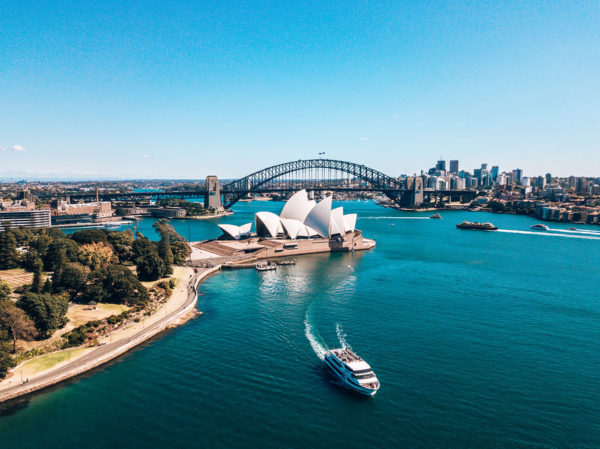
- Visa Description
Visa Details
- Criminal Convictions
Australian 6 Month Tourist Visa Application
Should you plan on visiting Australia for an extended stay (longer than 90 days), you will be required to apply for a long stay Australian tourist visa.
After the standard tourist visa (ETA visa), which allows for stays of up to 3 months (90 days) , there are other options available for stays of up to 6 months and stays of up to 12 months .
Australian Tourist visa for up to 6 months stay: What is permitted?
This visa permits you to stay in Australia (for the purpose of tourism) for up to 6 months at a time . (If you require longer periods of stay, you should choose the 12 month tourist visa option. If you plan to stay for 3 months or less, then the 3-month e-visa will be sufficient)
- Your 6 month tourist visa is valid for 12 months from the date it is issued.
- The visa allows for multiple visits, i.e. you will be permitted to leave and re-enter Australia as frequently as you like during this 12 month period.
- You may only stay for up to 6 months on each visit.
- You will not be able to re-enter after the anniversary of the date the visa was issued.
Requirements of a 6-month tourist visa
To be qualified to apply for a 6 month Australian visitor visa, you must agree with the following conditions:
- Your trip should be for tourism purposes – working is strictly prohibited!
- You must have the capacity to show proof of funds in your bank account that are sufficient to sustain you during the trip
- If somebody is providing accommodation we will require their details.
- You must not spend longer than 3 months studying while in Australia.*
* If you plan to study for longer than 4 weeks in Australia, you may be obliged to undergo a chest x-ray examination.
If you are over 75, you will be required to have medicals at an approved clinic
Note: If you have criminal convictions to declare, extra costs will be incurred.
Our Visa Application Support Service
Once we receive your online visa application, you will be allocated a named member of our team who will assist you through the process.
- Prepare a check list of suitable supporting information for your application
- Go though with you the detail and advise if anything requires amendment
- Prepare the presentation to Australian Immigration
- Advise on any queries that occur after the application is submitted
How long does it take to get a 6-month visa for Australia?
The typical processing for a 6-month tourist visa application is about 2 – 4 weeks from the time you supply all required supporting information (not from the date of the application).
If further Medical or Police Checks are required, then it will take longer. The exact time will depend on the exact pathway your application takes.
There will also be additional fees to pay if medicals or police checks are requested. These fees will be payable directly to the appropriate agencies.
If you are planning on travelling to Australia with a criminal record , the process is likely to take considerably longer, and it is likely that if you are granted a visa, it will be for a shorter stay than 6 months. If you do have criminal convictions, you need to follow the visa application process for individuals with criminal convictions
For further information of the travel visas options, read Australian Travel Visas
Criminal Convictions?
Australia has very strict rules regarding granting visas to individuals with Criminal convictions. You certainly can’t use the standard visitor visa applications.
There are bound to be some delays, and additional costs, but you may still be eligible
Ready to start your visa application?
Do you need assistance in selecting the right visa for you?
Request a consultation.
Complete your details here to request a Telephone Consultation
- Name * First Last
- Phone * The full international telephone number where we can contact you
- When would be a convenient time to contact you? *
- Details about your enquiry *
- Consent * The information that we collect will be used exclusively for the purposes of dealing with your enquiry. Read the full Privacy Policy I agree to the privacy policy.
- Email This field is for validation purposes and should be left unchanged.
Share this:

Australia Recommends 2024

Come and Say G'day

G'day, the short film

Discover your Australia

Travel videos

Deals and offers

Australian Capital Territory

New South Wales

Northern Territory

South Australia

Western Australia

External Territories

The Whitsundays

Mornington Peninsula

Port Douglas

Ningaloo Reef

Airlie Beach

Kangaroo Island

Rottnest Island

Hamilton Island

Lord Howe Island

Tiwi Islands

Phillip Island

Bruny Island

Margaret River

Barossa Valley

The Grampians

Hunter Valley

Yarra Valley

McLaren Vale

Glass House Mountains

Alice Springs

Uluru and Kata Tjuta

The Kimberley

Flinders Ranges

Kakadu National Park

Eyre Peninsula

Karijini National Park

Great Barrier Reef

Blue Mountains

Daintree Rainforest

Great Ocean Road

Purnululu National Park

Cradle Mountain-Lake St Clair National Park

Litchfield National Park

Aboriginal experiences

Arts and culture

Festivals and events

Food and drink

Adventure and sports

Walks and hikes

Road trips and drives

Beaches and islands

Nature and national parks

Eco-friendly travel

Health and wellness

Family travel

Family destinations

Family road trips

Backpacking

Work and holiday

Beginner's guide

Accessible travel

Planning tips

Trip planner

Australian budget guide

Itinerary planner

Find a travel agent

Find accommodation

Find transport

Visitor information centres
Deals and travel packages

Visa and entry requirements FAQ

Customs and biosecurity

Working Holiday Maker visas

Facts about Australia

Experiences that will make you feel like an Aussie

People and culture

Health and safety FAQ

Cities, states & territories

Iconic places and attractions

When is the best time to visit Australia?

Seasonal travel

Events and festivals

School holidays

Public holidays
How to get to Australia's most iconic cities

How long do I need for my trip to Australia?

How to travel around Australia

Guide to driving in Australia

How to hire a car or campervan

How to plan a family road trip

How to plan an outback road trip

- Australian visa information
- Working holiday visas

Sydney Airport, New South Wales © Sydney Airport
Travelling to Australia from the UK: Visa and Entry Requirements FAQs
Learn about visa requirements for entry to Australia for tourism purposes with this list of frequently asked questions.
Please note this page is intended to provide general information only and does not constitute legal advice. Tourism Australia is not the Australian government visa granting authority. For information on visas to enter Australia, visitors should seek the most up-to-date information from Australian Government Department of Home Affairs .*
Ready to plan your trip? We're ready to welcome you! Here are some helpful tips for getting your visa sorted:
- Be sure to secure the appropriate visa before travelling to Australia. Use the Visa Finder to explore your options.
- Ensure all details are correct and provide all required documents when you apply. An incomplete or incorrect application can delay your visa.
- Submitting multiple applications at the same time can slow the process. For visitor visas, submit one application per person, including children.
- Questions? The Australian Government's Global Service Centre can help.
Australian Visa Information
Unless you are an Australian citizen, you will need a valid Australian visa to enter the country. New Zealand passport holders can apply for a visa upon arrival in the country. All other passport holders, regardless of age, must apply for a visa before leaving home. You can apply for a range of Australian visa types, including tourist visas and working holiday visas, via the ETA app or on the Department of Home Affairs website.
There are different Australian visa types available for travellers to Australia. Knowing which Australian visa to apply for depends on the length of your stay, your passport and the purpose of your visit. You’ll also need to meet certain financial and medical requirements, be outside of Australia when applying and maintain health insurance for the duration of your stay.
Electronic Travel Authority visa (subclass 601) This visa allows you to visit Australia as many times as you want, for up to a year, and stay for three months each visit. This visa is available to passport holders from a number of countries and regions, who live outside Australia. A step-by-step guide on how to apply is here .
All ETA-eligible passport holders must apply for an ETA using the Australian ETA app. Agents can assist you in the application process, but you must be physically present as a live facial image is required.
eVisitor (subclass 651) This is a free visa for multiple visits to Australia for tourism or business purposes for up to three months at a time within a 12-month period. This visa is available to passport holders from a number of European countries and it cannot be extended.
Visitor visa (subclass 600) The Visitor visa allows you to visit Australia, either for tourism or business purposes. It is open to all nationalities. Generally, a period of stay of up to three months is granted, but up to 12 months may be granted in certain circumstances. Applicants will have to pay a fee to submit their application.
The application process may differ depending on which visa you need.
You can only apply for the Electronic Travel Authority visa (subclass 601) through the Australian ETA app. A step-by-step guide on how to apply is located here .
For other visas, you can apply online by creating an ImmiAccount and completing the application process. Be sure to submit your application well in advance of your travel date to allow enough time for processing. You may be asked to provide further supporting information. You will be notified in writing if your tourist visa is approved and it will be digitally linked to your passport. For more information on different visa types, and Australian visa requirements including how to apply for an Australian visa, visit the Department of Home Affairs website.
If you are already in Australia and hold a valid Electronic Travel Authority visa (subclass 601) you can extend your stay by applying for another visa, such as a Visitor visa (subclass 600). An eVisitor (subclass 651) cannot be extended.
See the Department of Home Affairs website for details.
Working Holiday Visas
Australia's Working Holiday Maker program allows visitors aged under 30 (or 35 in certain cases) who hold a passport from a participating country to travel and work in Australia. Working holiday visas are valid for one year, or up to three years if you meet certain conditions.
Find out more about working holiday visas here .
*Australian visa regulations (including visa application charges) change from time to time. The information provided here is valid at the time of publication, but visitors should check this information is still current by visiting the Australian Department of Home Affairs .
More articles like this

Acknowledgement of Country

We acknowledge the Traditional Aboriginal and Torres Strait Islander Owners of the land, sea and waters of the Australian continent, and recognise their custodianship of culture and Country for over 60,000 years.
- International (English)
- New Zealand (English)
- United States (English)
- Canada (English)
- India (English)
- Malaysia (English)
- Singapore (English)
- Indonesia (Bahasa Indonesia)
- Deutschland (Deutsch)
- France (Français)
- Italia (Italiano)
- 中国大陆 (简体中文)
*Product Disclaimer: Tourism Australia is not the owner, operator, advertiser or promoter of the listed products and services. Information on listed products and services, including Covid-safe accreditations, are provided by the third-party operator on their website or as published on Australian Tourism Data Warehouse where applicable. Rates are indicative based on the minimum and maximum available prices of products and services. Please visit the operator’s website for further information. All prices quoted are in Australian dollars (AUD). Tourism Australia makes no representations whatsoever about any other websites which you may access through its websites such as australia.com. Some websites which are linked to the Tourism Australia website are independent from Tourism Australia and are not under the control of Tourism Australia. Tourism Australia does not endorse or accept any responsibility for the use of websites which are owned or operated by third parties and makes no representation or warranty in relation to the standard, class or fitness for purpose of any services, nor does it endorse or in any respect warrant any products or services by virtue of any information, material or content linked from or to this site.
Featured on

- What is a visa?
- Electronic Visa (eVisa)
- Visa on Arrival
- Appointment Required Visa
- Invitation Letter
- Arrival Card
- Passport Renewal
- Project Kosmos: Meet the man with the world's most challenging travel schedule
- Australia Visa and ETA Requirements for US Citizens Explained
- Brazil eVisa for US Citizens
- India Tourist Visa for UK Citizens
- Possible B1/B2 Visa Questions During the Interview
Select Your Language
- Nederlandse
- 中文 (Zhōngwén), 汉语, 漢語
Select Your Currency
- AED United Arab Emirates Dirham
- AFN Afghan Afghani
- ALL Albanian Lek
- AMD Armenian Dram
- ANG Netherlands Antillean Guilder
- AOA Angolan Kwanza
- ARS Argentine Peso
- AUD Australian Dollar
- AWG Aruban Florin
- AZN Azerbaijani Manat
- BAM Bosnia-Herzegovina Convertible Mark
- BBD Barbadian Dollar
- BDT Bangladeshi Taka
- BGN Bulgarian Lev
- BIF Burundian Franc
- BMD Bermudan Dollar
- BND Brunei Dollar
- BOB Bolivian Boliviano
- BRL Brazilian Real
- BSD Bahamian Dollar
- BWP Botswanan Pula
- BZD Belize Dollar
- CAD Canadian Dollar
- CDF Congolese Franc
- CHF Swiss Franc
- CLP Chilean Peso
- CNY Chinese Yuan
- COP Colombian Peso
- CRC Costa Rican Colón
- CVE Cape Verdean Escudo
- CZK Czech Republic Koruna
- DJF Djiboutian Franc
- DKK Danish Krone
- DOP Dominican Peso
- DZD Algerian Dinar
- EGP Egyptian Pound
- ETB Ethiopian Birr
- FJD Fijian Dollar
- FKP Falkland Islands Pound
- GBP British Pound Sterling
- GEL Georgian Lari
- GIP Gibraltar Pound
- GMD Gambian Dalasi
- GNF Guinean Franc
- GTQ Guatemalan Quetzal
- GYD Guyanaese Dollar
- HKD Hong Kong Dollar
- HNL Honduran Lempira
- HTG Haitian Gourde
- HUF Hungarian Forint
- IDR Indonesian Rupiah
- ILS Israeli New Sheqel
- INR Indian Rupee
- ISK Icelandic Króna
- JMD Jamaican Dollar
- JPY Japanese Yen
- KES Kenyan Shilling
- KGS Kyrgystani Som
- KHR Cambodian Riel
- KMF Comorian Franc
- KRW South Korean Won
- KYD Cayman Islands Dollar
- KZT Kazakhstani Tenge
- LAK Laotian Kip
- LBP Lebanese Pound
- LKR Sri Lankan Rupee
- LRD Liberian Dollar
- LSL Lesotho Loti
- MAD Moroccan Dirham
- MDL Moldovan Leu
- MGA Malagasy Ariary
- MKD Macedonian Denar
- MNT Mongolian Tugrik
- MOP Macanese Pataca
- MUR Mauritian Rupee
- MVR Maldivian Rufiyaa
- MWK Malawian Kwacha
- MXN Mexican Peso
- MYR Malaysian Ringgit
- MZN Mozambican Metical
- NAD Namibian Dollar
- NGN Nigerian Naira
- NIO Nicaraguan Córdoba
- NOK Norwegian Krone
- NPR Nepalese Rupee
- NZD New Zealand Dollar
- OMR Omani Rial
- PAB Panamanian Balboa
- PEN Peruvian Nuevo Sol
- PGK Papua New Guinean Kina
- PHP Philippine Peso
- PKR Pakistani Rupee
- PLN Polish Zloty
- PYG Paraguayan Guarani
- QAR Qatari Rial
- RON Romanian Leu
- RSD Serbian Dinar
- RUB Russian Ruble
- RWF Rwandan Franc
- SAR Saudi Riyal
- SBD Solomon Islands Dollar
- SCR Seychellois Rupee
- SEK Swedish Krona
- SGD Singapore Dollar
- SHP Saint Helena Pound
- SLL Sierra Leonean Leone
- SOS Somali Shilling
- SRD Surinamese Dollar
- SVC Salvadoran Colón
- SZL Swazi Lilangeni
- THB Thai Baht
- TJS Tajikistani Somoni
- TOP Tongan Pa anga
- TRY Turkish Lira
- TTD Trinidad and Tobago Dollar
- TWD New Taiwan Dollar
- TZS Tanzanian Shilling
- UAH Ukrainian Hryvnia
- UGX Ugandan Shilling
- USD United States Dollar
- UYU Uruguayan Peso
- UZS Uzbekistan Som
- VND Vietnamese Dong
- VUV Vanuatu Vatu
- WST Samoan Tala
- XAF CFA Franc BEAC
- XCD East Caribbean Dollar
- XOF CFA Franc BCEAO
- XPF CFP Franc
- YER Yemeni Rial
- ZAR South African Rand
- ZMW Zambian Kwacha
We've updated our app!
Download it now
Australia ETA processing time: How long does it take?
Knowing how long it takes to get your Australia ETA is key for a smooth trip.
Getting to Australia is more than just packing and booking your flight; you need the right paperwork, too. The Australia ETA, which is necessary for eligible passport holders, makes entering the country much easier than the traditional visa route.
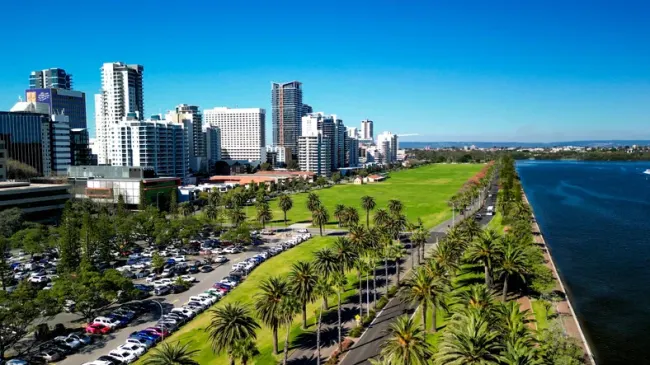
It's important to understand how long it takes to process the ETA, as any delays could upset your travel plans. This blog will be your detailed resource for everything related to the ETA processing time, helping you better manage your travel prep.
Understanding the Australia ETA processing time
The standard processing time for an Australia ETA is generally quick and can take 1 to 3 business days . However, this period can vary depending on factors such as the volume of applications received, the accuracy of the information provided in the application, and the need for additional checks like health, character, and national security.
To significantly reduce the chances of a delay in processing your travel document, we recommend applying for your Australian ETA through our platform . You’ll gain access to a team of visa experts who’ll review your application to ensure it’s accurate and error-free and that all the required information has been provided.
We also offer different processing times to accommodate different travel needs. Standard Processing takes about two days, while Rush Processing delivers the ETA within 24 hours. If you choose the Super Rush Processing, you can get your ETA in as little as 6 hours .
Do I need to apply for an Australia ETA or eVisitor Visa?
Both the ETA and the eVisitor Visa are electronic travel authorizations allowing travelers to visit Australia for tourism or business purposes. They are valid for one year and permit multiple entries, with each stay lasting up to three months.
The primary difference between the two lies in the nationalities eligible to apply. The Australia eVisitor Visa is only available to countries in Europe . This includes EU and EFTA member states, non-EU countries like the United Kingdom, and European microstates like Andorra, Monaco, and Vatican City.
On the other hand, the Australia ETA is available to European countries, North America, and some Asian countries like Brunei, Japan, and Singapore .
Tips for a smooth Australia ETA application
Check passport validity : Before applying, make sure your passport is valid. Australia does not require the six-month passport validity rule, but some airlines do, so you should check with your airline before you book your flight.
Apply early : Start the application process at least four weeks before your travel date to allow time for any necessary follow-ups or additional information requests.
Consider professional assistance: If you’re not sure about any part of the application process or face issues, you can get help from a reputable visa agency like iVisa.
What should every traveler know before visiting Australia? Check out our trip guide .
Get support for your Australia ETA application
If you’d like to apply for an Australia ETA and need more information, you can get in touch with our customer support team . Contact them any time via WhatsApp or through the iVisa chat .
Related Articles
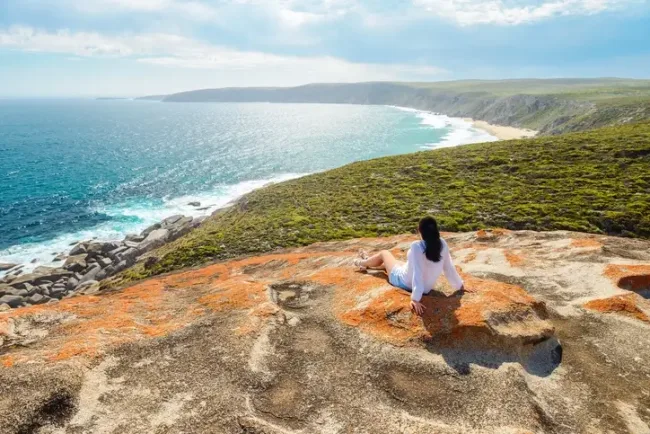
Australia visa rejection: Common reasons and how to avoid it
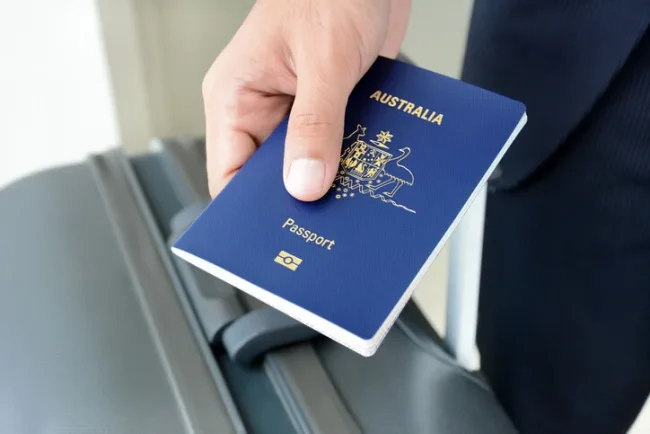
Australian passport renewal: Everything you must know
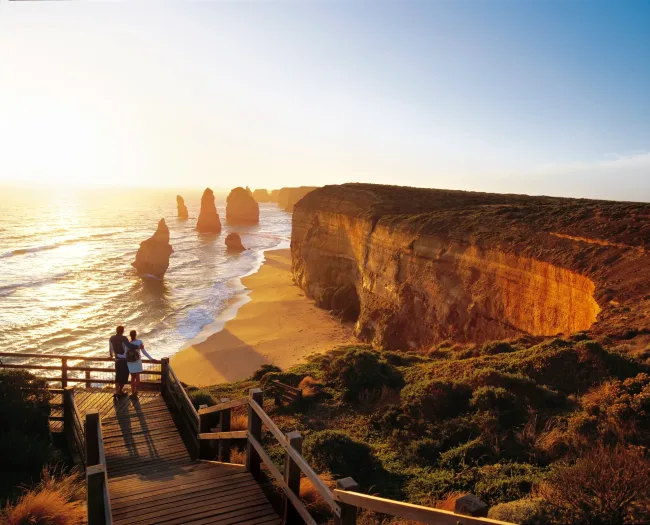
Australia Visitor Visa for Vanuatuan citizens: Requirements and application
- iVisa is NOT affiliated with any government agency. This site does not provide legal advice and we are not a law firm. None of our customer service representatives are lawyers and they also do not provide legal advice. We are a private, internet-based travel and immigration consultancy provider dedicated to helping individuals travel around the world. You may apply by yourself directly on the various government websites. The source of information: https://immi.homeaffairs.gov.au/

Australia Tourist Visa for Indians: Requirements & Fees
Last Updated : 11 Apr 2024
Last Updated : 11 Apr 2024 at
30-Second Summary
Indian nationals travelling to Australia for tourism purposes must have a valid visa to enter the country.
The Australian tourist visa is an e-visa that you can apply for online through Atlys or the government website.
It does not require you to submit your passport or visit any embassy for interviews.
Apply on Atlys and get a full refund if your visa is rejected.
Important Information
— Visa type
— Australia visa cost
— Australia tourist visa processing time
— Australia visa validity
— Length of stay
Do Indians need a visa for Australia?
Yes. Indian passport holders must apply for an Australian visitor visa before travelling. Australia does not provide visa-free access to Indians, whether their visit is for tourism or business activities.
Indian nationals can apply online for an Australia visitor visa (subclass 600), also known as the ‘Australian e-visa.' This visa enables Indians to travel to Australia for tourism, to see family and friends, or for reasons other than business or medical treatment.
One of the most convenient visa options is the e-visa, enabling you to complete the application process online. You can apply for an e-visa on Atlys or the official government website.
Can Indians get an Australia visa on arrival?
No. Indian passport holders are not eligible for a visa on arrival in Australia. To enter Australia, you must apply for a visa before travelling. Indian nationals can apply for a tourist visa through Atlys or the government website.
Australia tourist visa requirements for Indians
When applying for an Australian tourist visa online, you must submit the following required documents:
Valid passport: Submit a scanned copy of your passport's information page with your photo and details visible. Your passport must be valid for 6 months beyond your arrival date and have 2 blank pages.
Visa photo: Submit a digital passport-sized photo (35 x 45mm) with a white background.
With Atlys , you can easily upload your required documents using the camera on your smartphone or laptop.
Australian visa fees for Indians
The Australian tourist visa fee for Indian nationals is ₹ 10,979* for each applicant.
You are guaranteed a ₹8000 full refund (excluding the service fee) from Atlys if your visa application is not approved.
*Note that the Australia visa fees will be charged as per the exchange rate on the day of your application.
Australia visa application process for Indians
How to apply through atlys.
To apply seamlessly and without any hassle, follow these steps for your visa application on Atlys:
Start application: Start your Australia visa application on Atlys .
Upload or capture your photograph: You can upload a pre-existing photo or capture a new one directly through Atlys using your smartphone or laptop.
Submit your information: Provide the necessary personal and travel information accurately.
Complete and pay: Complete the application and pay the Australia visa fee for Indians.
Receive your visa: Download and print your visa after it's processed.
Why choose Atlys
Australian visa approval times are uncertain, often taking up to 30 days. Atlys guarantees the exact date when you will receive your visa. Review your visa timeline here .
Atlys has tie-ups and public relations officers at the Australian Immigration to ensure that visas arrive on time.
You can apply for your entire family on Atlys in one go.
How to apply through the government website?
Indian citizens can choose to handle the Australia tourist visa application themselves by applying through the government website; here’s how:
Access the Australian immigration website: Create an ImmiAccount by following the on-screen instructions.
Fill in the application: Complete the online application form by entering the necessary information, such as passport details, date of birth, and travel dates.
Upload documents: Upload the required documents by selecting their type and attaching the required files.
Review your application: Scroll to the bottom of the page to review your application. Ensure all information is accurate, or you can go back and edit if necessary.
Make payment: Keep your credit card handy to pay the Australia visa fees for Indians. Follow the instructions to finish the payment process. A 5% surcharge will be added to most international cards for AU$ transactions, but you can avoid this fee by using Atlys .
Check application status: You can monitor the status of your e-visa application online at any time after submission.
Download and print e-visa: Once approved, visit the website again to download your e-visa. Print a copy to present to the Immigration Officer upon arrival at the international airport or other designated port of entry in Australia.
Additional documents to be submitted:
When you handle the application process yourself, additional documents are required; they include the following:
A cover letter: Include your passport details, travel plans, and sponsorship details.
Proof of funds: Provide bank statements, employment proof, and pay slips to demonstrate your financial capability. You must have at least AU$ 1000 to 15000 ( approximately ₹ 51,206).
Accommodation: Show hotel bookings or proof of where you'll stay in Australia.
Flight reservation: Provide evidence of a flight ticket (round trip or return ticket).
PAN card (Permanent Account Number): Enter your ten-digit alphanumeric identification number on your PAN card.
Marriage certificate: If you are a married individual applying for an Australian tourist visa, providing a marriage certificate may be necessary to establish the legal status of your relationship.
Income tax returns: Provide your recent ITR statements.
Invitation letter (if applicable): The letter must state their relationship to you, the purpose of your visit, the length of stay if you stay with them, and if this person will be paying for your stay.
Itinerary: You will need to provide details about your trip.
Tips to apply
Make sure the documents you upload are small file sizes.
Complete your application form with accurate information that matches your travel documents.
Submit your e-visa application well before your intended travel date to allow ample time for your visa to be processed.
After submitting, regularly check your e-visa application's status online to promptly address any follow-up requirements or corrections.
Receive your approved Australia visa for Indians
After submitting your visa application, you must wait for processing. Remember to apply for your e-visa to Australia from India early to ensure enough time for processing.
Through Atlys:
Atlys will promptly notify you when your visa is approved. Next, you can easily download the e-visa and print a copy before travelling to Australia.
Through Government:
Once your Australia tourist visa for Indians is processed, the Australian Home Affairs will inform you of the following:
The start date of your visa.
Your visa grant number.
The conditions of your visa.
Keep a copy of this decision while you're in Australia.
How the approved Australia e-visa looks:
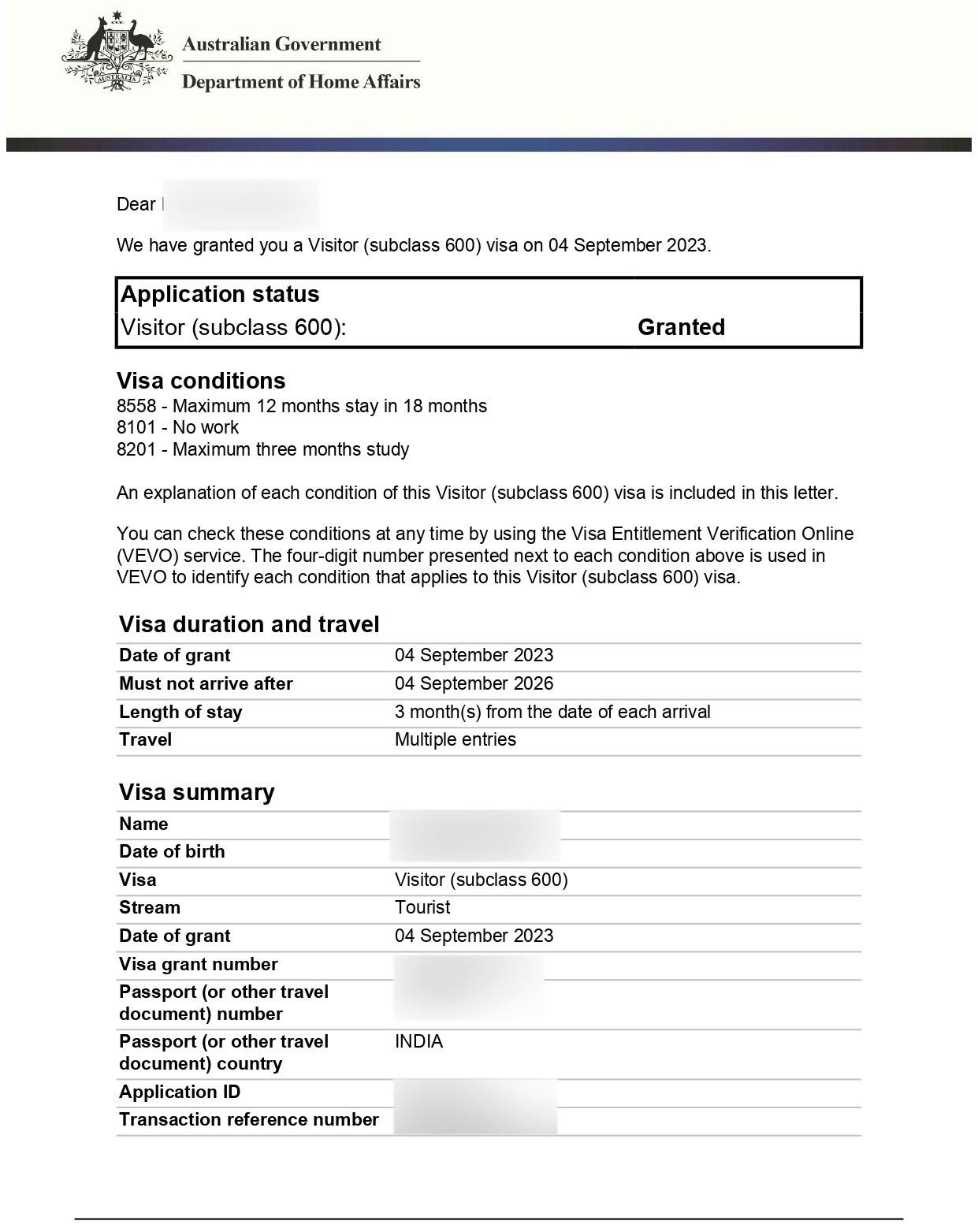
Australia visa information for Indians
How to check your australia e-visa status.
After you apply for your visa, you can check your Australia visa status online by following these steps:
Visit the official website.
Find the visa application status section.
Enter your application reference number, passport number, and date of birth.
View your application status: pending, approved, or rejected.
Download and print your visa if approved.
Alternatively, contact the embassy or visa processing centre for help.
How can I check my Australia visa status on Atlys?
Atlys provides real-time updates to keep you informed. Here's how you can check your status:
Download the Atlys app .
Select “Profile” and then “My Documents”.
Inside "My Documents," find your Australia visa.
Click on your visa to access its current status.
Australia tourist visa processing time
The tourist visa processing time can be up to 30 days or more. Atlys provides a guaranteed date for when you will receive your visa so you can plan accordingly.
Australia tourist visa validity & length of stay
The Australian tourist visa is valid for 3 years from the date of issue. It permits multiple entries into the country and allows you to stay up to 90 days.
Remember that the length of stay granted by Australian officials may not always match your preferred duration.
Our commitment to visa accuracy
All the information in this blog is sourced from official government websites, ensuring reliability and accuracy. You can trust the content to be accurate, but remember to stay informed, as changes may happen without notice.
Australia home affairs
Government fees and processes can change over time. Atlys recommends double-checking the government website for the most current and up-to-date information before applying.
We’re here to answer all your questions
At Atlys , you will receive a ₹8000 refund, excluding the service fees, if your visa is rejected.
After your Australia tourist visa from India gets rejected, you will be notified of the reason for rejection. Oncethese rejection reasons have been fixed, you can reapply for your visa.
You will lose the funds when applying through the government or other visa sites.
Purpose of visit: This visa is suitable for visiting Australia for tourism, seeing family or friends, or short-term business purposes.
No study: While on this visa, you are not allowed to engage in formal study or training courses that exceed three months in duration.
No extension: This visa typically does not allow for an extension of the stay beyond the initial grant period. Visitors must leave Australia before the visa expires.
Eligibility: To be eligible, applicants must demonstrate that they genuinely intend to visit Australia temporarily and have the means to support themselves during their stay.
Return or onward travel: Immigration authorities may ask for evidence of a return or onward ticket when a visitor enters Australia to ensure he or she does not intend to overstay.
No work: Visitors on this visa cannot work in Australia, although they can engage in limited business-related activities, such as attending meetings or conferences.
Yes, a friend can sponsor you for a visitor visa to Australia. The sponsor can be a friend or family member who is either a citizen or permanent resident of Australia or even an Australian-based organisation. They must be able to offer accommodation and financial support for the duration of your stay in Australia.
You must have at least 5,000 AU$ in your bank account, which you can prove by providing a three-month bank statement.
There are additional documents for Indian citizens under 18. You must provide a copy of the birth certificate showing both parents' names. If you can't provide the birth certificate with your parents' names, you can provide the following.
Identification pages of a family book showing the names of both parents.
Identification pages of identification documents issued by the document.
Identification pages of a court-issued document that proves your Identity.
Identification pages of a family census register.
If somebody other than your biological parents has legal guardianship (adoptive parents or court-ordered guardianship) over you. You must provide proof of their legal guardianship.
Finding immigration area: After disembarking, follow signs labelled 'Immigration' or 'Passport Control'.
Queueing: Lines can vary; ensure you're in the right queue (e.g., citizens, visitors).
Interacting with the immigration officer: Be ready with your passport and visa. Answer any questions truthfully.
Biometrics: Many countries require a fingerprint scan and photograph.
Entry stamp: Upon approval, your passport gets stamped. Quickly verify the stamp's details.
Log into ImmiAccount.
Go to your application.
Click on the 'view health assessment' link in the application status section.
Suppose they need you to have health examinations. You will find a link there called 'organise health examinations.' There will be no link if you don't need a health examination.
Click on the link and complete your medical history.
When you complete your medical history, you'll get a referral letter with a HAP ID identifier. You will need the HAP ID to arrange the health examination.
No, you can't extend your visa. You must apply for a new visa before your current visa expires.
Visas in Under a Week

Cyprus Visa for Indians: Requirement, Fees & How to Apply
Cyprus visa for Indians
Learn how to secure a Cyprus visa for Indians, from booking a Schengen visa appointment, paying the fees, to in-person submission of the required documents.

Oman Visa for Indians: Online Visa Requirements & Fees
Oman Visa for Indians
Check out our guide on the Oman visa for Indians and learn about the application process, fees, validity and more

How Indians Can Apply For A Dubai Visa
In this post, you will find how Indians can apply for their Dubai Visa. We will also cover different ways to apply for your Dubai Visa and the required documents.

Indonesia Visa for Indians: Online Visa Requirements & Fees
Indonesia E-Visa for Indians
Learn about the visa requirements, fees, processing time, and visa validity. Follow our step-by-step guide to apply for an Indonesia visa for Indians.

Malaysia Visa for Indians - New Visa Changes with MDAC
Malaysia visa for Indians
Learn the new policy updates for the Malaysia visa for Indians. Our detailed guide includes the new visa regulations, requirements, and related fees.

Myanmar E-Visa for Indians: Online Visa Requirements & Fees
Myanmar Visa For Indians
Know more about the essential steps to obtain Myanmar visa for Indians. Includes up-to-date info on requirements, fees, and application tips for Indian travellers.
Instant Visas
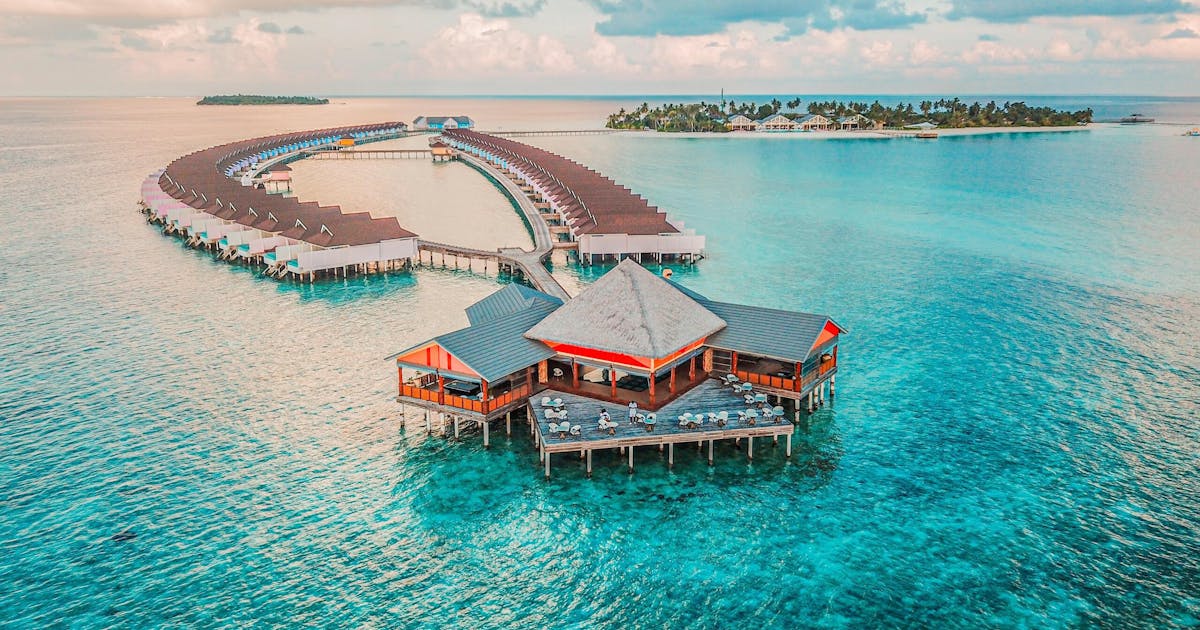
Maldives Visa for Indians: Visa on Arrival & Requirements
Maldives Visa for Indians
Plan your Maldives trip with ease. Find out everything about the Maldives visa for Indians, from the required documents to the on arrival application process.

Bhutan Visa for Indians: Visa Free Entry & Travel Requirements
Bhutan Visa for Indians
Explore Bhutan without the visa hassle: A guide for Indians on visa-free entry, the Bhutan entry permit, and what you need to know for a smooth travel experience.
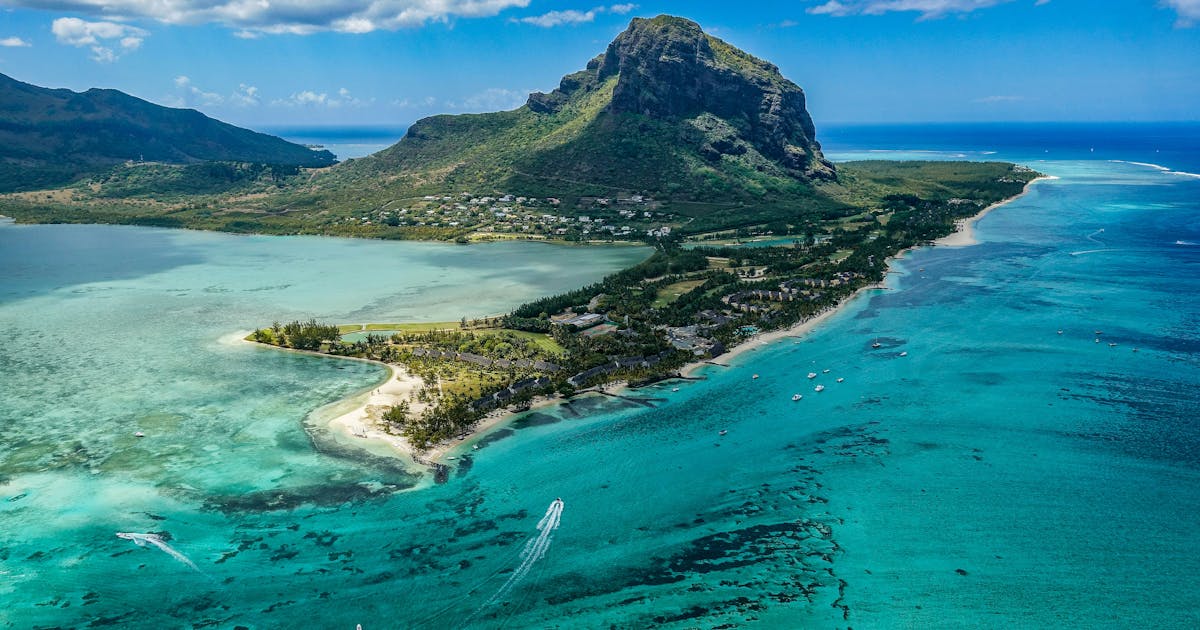
Mauritius Visa for Indians: Visa on Arrival & Requirements
Mauritius Visa For Indians
Simplify your Mauritius journey with our ultimate guide on the Mauritius visa for Indians. Learn about the visa requirements, visa-on-arrival process, fees, and more.

Nepal Visa for Indians: Visa Free Entry & Travel Requirements
Nepal Visa For Indians
Explore Nepal without the visa hassle as an Indian traveler by understanding the visa-free entry and documents required to enter Nepal from India.

Thailand E-Visa on Arrival for Indians: Fee, Requirements & Process
Thailand E-Visa on Arrival
Get your Thailand visa for Indian travellers with ease. Learn about processing times, required documents, fees, validity, and tips for hassle-free entry in Thailand.

Seychelles Visa for Indians: eTA Requirements & Application
Seychelles Visa For Indians
Your complete guide to Seychelles visa for Indians: Learn about requirements, costs, and travel tips for an unforgettable experience.
Visa Guaranteed on
Your client portal login provides access to your organization’s preferred pricing and customized features
- About Us CIBTvisas Global Offices Immigration Services CIBTvisas Global Leadership CIBTvisas Careers Contact CIBTvisas In The News
- Travel Visas Do I Need a Visa? Expedited Visa Solutions Travel Visa FAQs Corporate Travel Solutions
- Passports Same Day Passport Passport Renewal First-Time Passport Lost or Stolen Passport Child Passport Name Change Second Passport Passport FAQs
- Document Services
- Resources CIBTvisas Travel Blog Destination Entry Requirements Podcast ETIAS White Papers Research
- Services Global Immigration Services US Immigration CIBTvisas Service Directory Learn More About Our Services Corporations Cruise Lines Tour Operators Onsite Services All Partner Solutions Learn More About Our Client Solutions
- Your Order Check Order Status View Invoice Upload Documents
How Long Does It Take to Get a Chinese Visa?
By: Paul Buckley
January 23, 2024
Travelers planning trips to China often ask how long it takes to get a Chinese visa. As of November 14, 2023, the average processing time for a Chinese visa application was approximately eight business days.
However, various factors, such as seasonality, application volume, and the specific type of visa, can affect this timeframe. For the most accurate and up-to-date information, travelers should consult CIBTvisas' Check Requirements page.
While the average processing time is eight days, external factors may extend processing times by five to seven working days. For a small fee, CIBT's expedited service can shorten this period to four to seven working days.
Applying early will accommodate any unforeseen delays. Travelers should request their China visa at least one or two months before departure.
Do US citizens need a visa for China?
Yes, all US citizens must have a visa to enter China. The type of visa required depends on the purpose of the visit. The Chinese government has strict rules regarding visa validity on entry and exit.
As the US Department of State advises :
US citizens must have a valid visa to exit China and must leave China before their authorized visa expires.
You may apply for a visa extension from the local Entry-Exit Bureau of the Chinese government. However, you must do so before leaving China. These requests take time, so applications should be filed well ahead of your visa's expiration.
After you enter China, you must register your stay within 24 hours of arrival. Failure to do so can result in fines and deportation. Travelers can register with hotel staff or the local police station.
Foreigners must always carry their passports, visas, or residence permits under local regulations.
Several people can check your visa, including the police, school administrators, transportation officials, and hotel staff.
The Chinese government strictly enforces restrictions on activities allowed by particular visa classes and entry and exit requirements.
Staying in China on an expired visa could lead to fines, imprisonment, and deportation.
The Chinese government permits 144-hour visa-free transit for 20 cities in mainland China, including Beijing, Shanghai, Guangzhou, Chengdu, Hangzhou, Nanjing, and Shenzhen. Seventy-two-hour visa-free transit is permitted in Guilin, Harbin, and Changsha. Most cities in China offer 24-hour visa-free transit for international travelers.
Visa-free transit applies only to the transit city. It does not allow travel outside the city, regardless of the permit’s duration.
Types of Chinese visas available for US citizens
There are several types of Chinese visas. Categories L/M/Z/X/G are most commonly used by US citizens.
How does a US citizen get a visa to enter China?
On their own, US citizens can apply for a Chinese visa through multiple channels with the Chinese embassy, consulate, or online application forms.
The Chinese visa-application process includes some complex requirements and supporting documents. Errors in your visa application can lead to delays or denial. To avoid these complications, travelers can also apply via CIBT .
Appointment-based system and processing times
The Chinese consulate general uses an appointment-based system for visa submissions. After you have submitted the application and your documents are approved, CIBTvisas will schedule your appointment at a convenient time.
Because of limited availability, the waiting time for an appointment can take up to 30 business days. The visa processing time referenced here is how long you must wait to receive the visa after your appointment. Travelers should factor in this additional appointment time requirement when requesting a visa for China.
Ten-year visa issued before March 28, 2020
With the lifting of COVID-19 restrictions, travelers can once again use a China 10-year visa issued before March 28, 2020. However, if you have changed your name since obtaining the visa, it is no longer valid—all Chinese visas must match the name on your passport, so you'll need to apply for a new one.
Requirements for select US citizens born abroad
US citizens born in certain countries who plan to enter China with an American passport must appear at the same embassy or consulate for their China visa application. These countries are Afghanistan, Cameroon, Iraq, Iran, Pakistan, Nigeria, Tunisia, Turkey, and Syria. CIBTvisas cannot assist with this particular visa request.
Requirements for US citizens with criminal records
Travelers with criminal records who want to apply for a China visa must appear at the consulate to provide biometrics.
Limited-validity second passports
Limited-validity second passports are not accepted for the China visa application process.
Express service: China visa application
Express processing options are available for Chinese visas through CIBTvisas for an additional fee.
What is the fastest way to get a visa for China?
The fastest way to get a Chinese visa is by opting for expedited processing service, which can process your visa within five to seven working days. Always ensure your application is complete and accurate to avoid delays.
What are the requirements for a Chinese visa for US citizens?
US citizens must submit documentation relevant to their visa type along with the completed visa application form. Required documents include the applicant's passport, valid for at least six months, a recent photo, a travel itinerary, and an invitation.
Be prepared for a successful trip with CIBTvisas
Navigating the visa-application process for China requires careful management of requirements. Travelers can ensure a smooth application process by staying informed, planning, and getting sound advice on their visa applications and needs.
Remember to verify all information with official resources and begin your application on time before your trip. An experienced visa specialist can help you navigate the complexities of border-crossing requirements. Contact CIBTvisas to learn more today.
CIBTvisas Monthly Update
Get the CIBTvisas Monthly Update for the most recent information on travel requirements and consular closings.
Sign Up Now
About CIBTvisas
- Travel Visas
CIBT Around the World
- netherlands
- switzerland
- United Kingdom
- United States
Top Destinations
- Vietnam Visa
- Brazil Visa
- Australia Visa
- Indonesia Visa
- Saudi Arabia Visa
- 800-929-2428
- Learn More About Our Client Solutions
- Privacy Policy
- Terms & Conditions
- Copyright 2024
- Privacy Shield Compliant
- TRAC Certified
- As Seen in The New York Times

COMMENTS
The information below shows the median visa processing times for key visa categories. This is the most accurate way to show the amount of time it is taking most visa applications to be finalised. Visa processing times vary between different visas within these categories, and in some cases it may take longer for those visas to be finalised.
Australia's Working Holiday Maker program allows visitors aged under 30 (or 35 in certain cases) who hold a passport from a participating country to travel and work in Australia. Working holiday visas are valid for one year, or up to three years if you meet certain conditions. Find out more about working holiday visas here.
The Department of Home Affairs acknowledges the Traditional Custodians of Country throughout Australia and their continuing connection to land, sea and community. We pay our respects to all Aboriginal and Torres Strait Islander peoples, their cultures and to their elders past, present and emerging. For tourists, business visitors or to visit ...
Here are some general estimates for how long immigration to Australia takes: Tourist Visa. The processing time for a tourist visa (subclass 600) can range from a few days to a few weeks, depending on the volume of applications received. Student Visa
Factors such as application volumes, seasonal peaks and complex cases may also affect how long it takes to approve your visa. Visa subclass. Visa description. 75% of applications are processed in: 90% of applications are processed in: 408. Temporary Activity visa (Superyacht Crew) 7 days. 16 days.
Step 3: Enter your address, phone number and email. Select whether you wish to receive communications by SMS and declare whether you hold any passports issued by other countries. Step 4: Confirm your information. Step 5: Pay the online service charge of 20 Australian dollars (about $14) using a credit card.
The cost for a work and holiday tourist visa is of $ 625.00 as of 2024, but additional costs may also arise, including costs for police certificates, biometrics and health checks. Processing time can take from 13 to 22 days but may take longer if more information is needed or for verification purposes.
Eligibility: All nationalities are eligible. Validity: Valid for 6 months, 1 year or 3 years with single or multiple entries. Duration of stay: Generally, 3 months allowed stay, but up to 6 or 12 in some cases. Visa fee: Visitors visa fee is 190 AUD. Processing time: 50% of applications are processed in 7 days and 90% in 21 days.
The Australian Department of Home Affairs strives to process visa applications as quickly as possible, but it is important to allow sufficient time for your application to be assessed. On average, the processing time for an Australian tourist visa is approximately 17 to 32 days.
10 months. 771 Transit. 14 days. 26 days. *Processing times for the Tourist stream range from 48 hours to more than 20 days depending on factors such as peak processing periods in a particular location. Work and skilled visas. 124 Distinguished Talent. 24 months. 27 months.
Most visitors to Australia will need a visa, but the type of visa you apply for depends on your country of origin, how long you plan to stay in Australia and what you plan to do while you're there. Most tourists must apply for either an Electronic Travel Authority (ETA) or a visitor visa before traveling. The exception is New Zealand passport ...
If you would like to come to Australia for a holiday, you will need to apply for a visitor visa. There are three types of visitor visas and your country of origin will determine which visa you can apply for, including: Visitor visa (subclass 600); Electronic Travel Authority visa (subclass 601); and; eVisitor (Subclass 651) 601 & 651 Visa ...
A Visitor (Business) subclass 600 visa granted in relation to an ABTC allows travel for short-stay business purposes as well as short non-business travel, such as to have a holiday or visit family and friends.
student visa: Typically processed in 21 days; visitor visa: Typically processed in less than a day; working holiday maker visa: Typically processed in less than a day; Australia subclass 500 visa processing time. The processing time for an Australian student visa (subclass 500) can vary and is influenced by several factors.
The Subclass 600 visa allows for various purposes such as tourism, business visits, visiting family, and short educational courses under three months. Choose from visa durations of three, six, or twelve months with straightforward conditions. It can serve as a short-term extension if your current visa, like a student visa, is expiring.
Visas to visit Australia. Whether you are visiting Australia for less than 72 hours or planning on a stay of several years you must have a valid Australian visa. A visa is a form of permission for a non-citizen to enter, transit or remain in a particular country. Information on visas to Australia can be found at the Department of Home Affairs.
*Product Disclaimer: Tourism Australia is not the owner, operator, advertiser or promoter of the listed products and services.Information on listed products and services, including Covid-safe accreditations, are provided by the third-party operator on their website or as published on Australian Tourism Data Warehouse where applicable.
The duration of stay permitted on a tourist visa in Australia varies depending on the type of visa you hold. Let's take a closer look at the duration of stay for each of the three main tourist visa types: Electronic Travel Authority (ETA) subclass 601: With an ETA visa, you can stay in Australia for a maximum of three months per visit.
Should you plan on visiting Australia for an extended stay (longer than 90 days), you will be required to apply for a long stay Australian tourist visa. After the standard tourist visa (ETA visa), which allows for stays of up to 3 months (90 days) , there are other options available for stays of up to 6 months and stays of up to 12 months .
Australia's Working Holiday Maker program allows visitors aged under 30 (or 35 in certain cases) who hold a passport from a participating country to travel and work in Australia. Working holiday visas are valid for one year, or up to three years if you meet certain conditions. Find out more about working holiday visas here.
Understanding the Australia ETA processing time. The standard processing time for an Australia ETA is generally quick and can take 1 to 3 business days. However, this period can vary depending on factors such as the volume of applications received, the accuracy of the information provided in the application, and the need for additional checks ...
Australia visitor visa (subclass 600); commonly referred to as the "Australia e-visa." The Australia tourist visa fee for Indians is ₹ 10,979. The visa processing time via the government website is 30 days. Atlys guarantees the date when you will receive your visa. The Australian tourist visa is valid for 3 years.
Travelers planning trips to China often ask how long it takes to get a Chinese visa. As of November 14, 2023, the average processing time for a Chinese visa application was approximately eight business days. However, various factors, such as seasonality, application volume, and the specific type of visa, can affect this timeframe.